THE PEDAL ISSUE



THE MUSICIAN’S RESOURCE DEC./JAN. ‘23 FREE
brought to you by
Give the musician on your list the gift of recording with an audio interface from Focusrite. To bring music to your ears this holiday season, Scarlett interfaces are more affordable than ever with special pricing across the entire range!* When Scarlett is on your shopping list, there is no gift receipt needed.
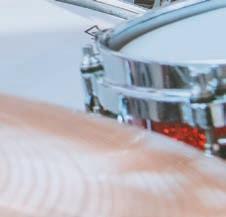

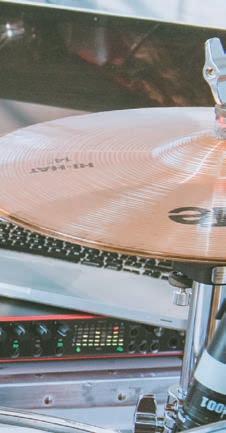








You’ve given them enough socks, this year get them the Scarlett they truly want!









SAVE UP TO $50 WHEN YOU GIVE THE GIFT
OF SCARLETT!
*Special pricing valid November 1, 2022, through December 31, 2022, only. www.focusrite.com/scarlett
This Is History
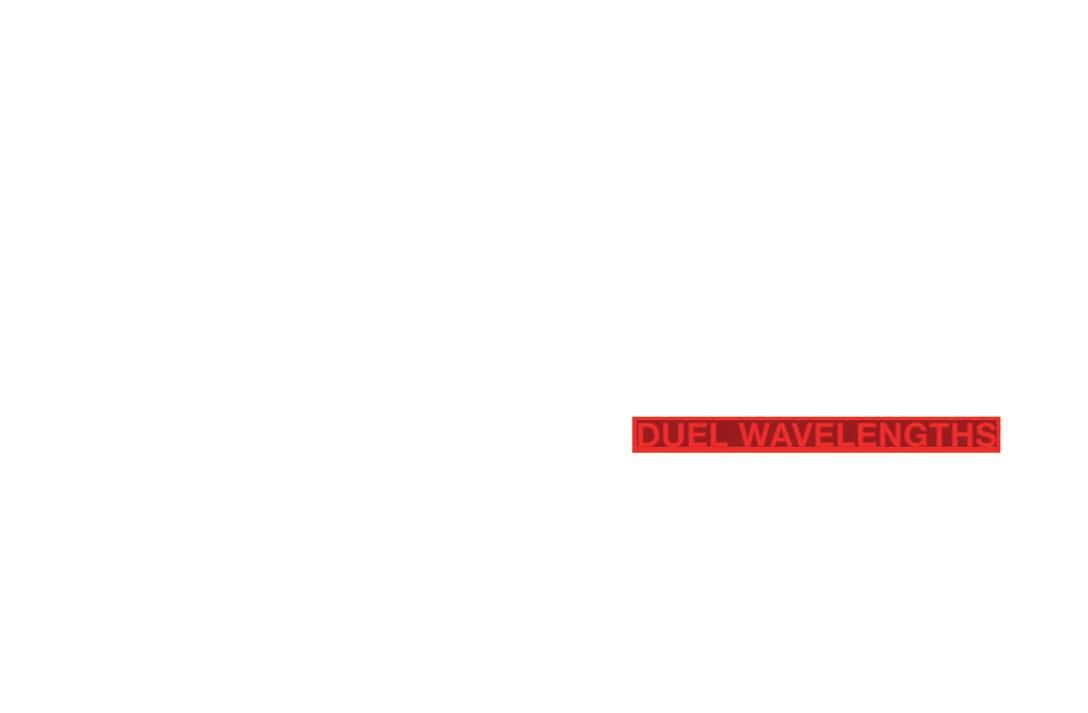
The Roots of Rock
The 1484 Twin Twelve™ Pedal Meticulously designed and engineered from scratch to recreate the renown Silvertone “Twin Twelve™” model 1484 guitar amp, both in sound and looks. Use it as a studio grade preamp, booster, e Q or overdrive. Played side by side... you can’t tell which is the original amp and which is the new pedal.

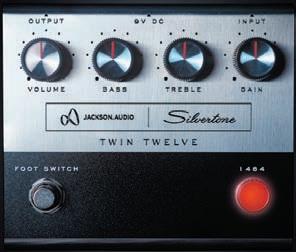

RBi Music SilvertoneGuitar S .com • r Bi muS ic.com
©2022
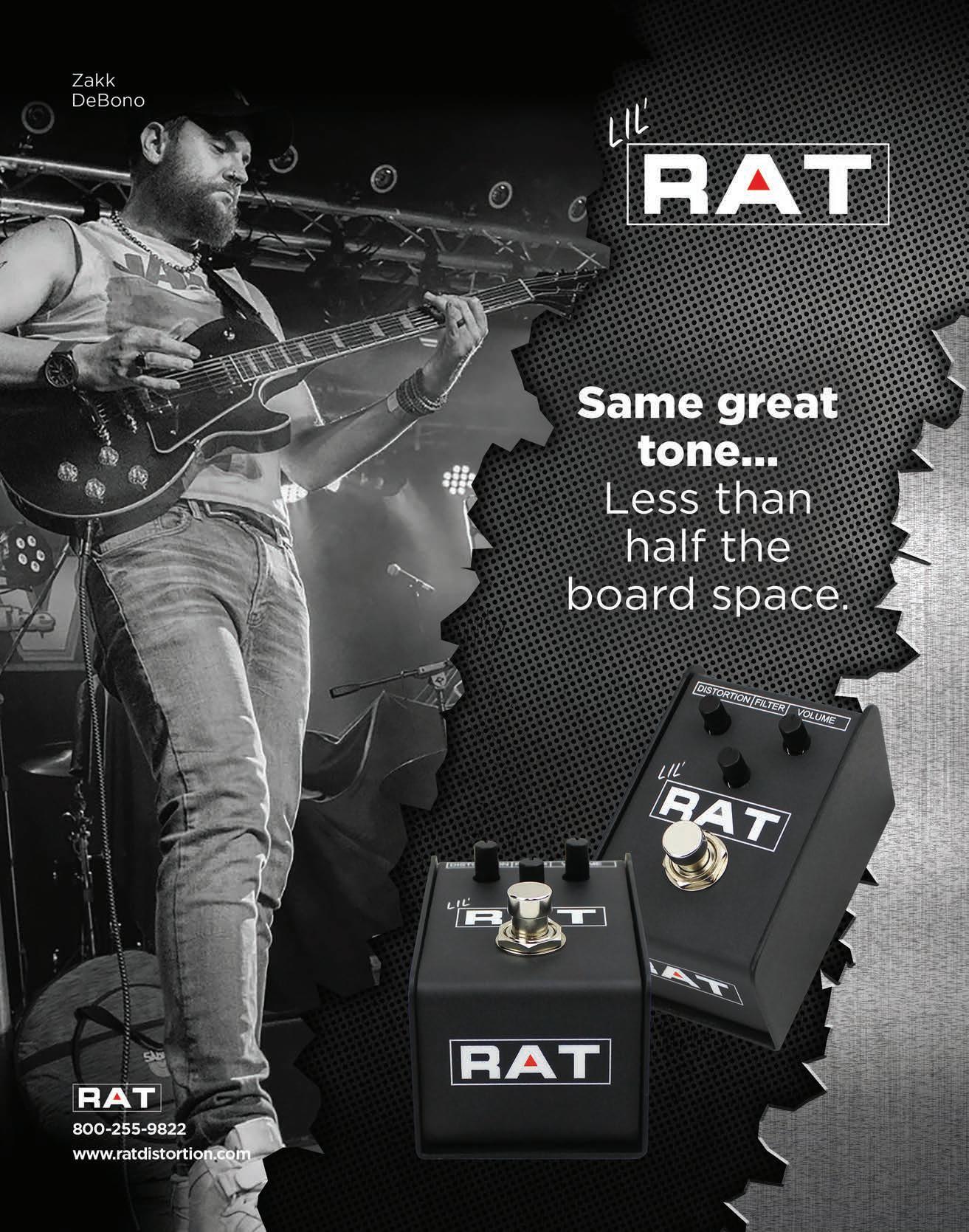



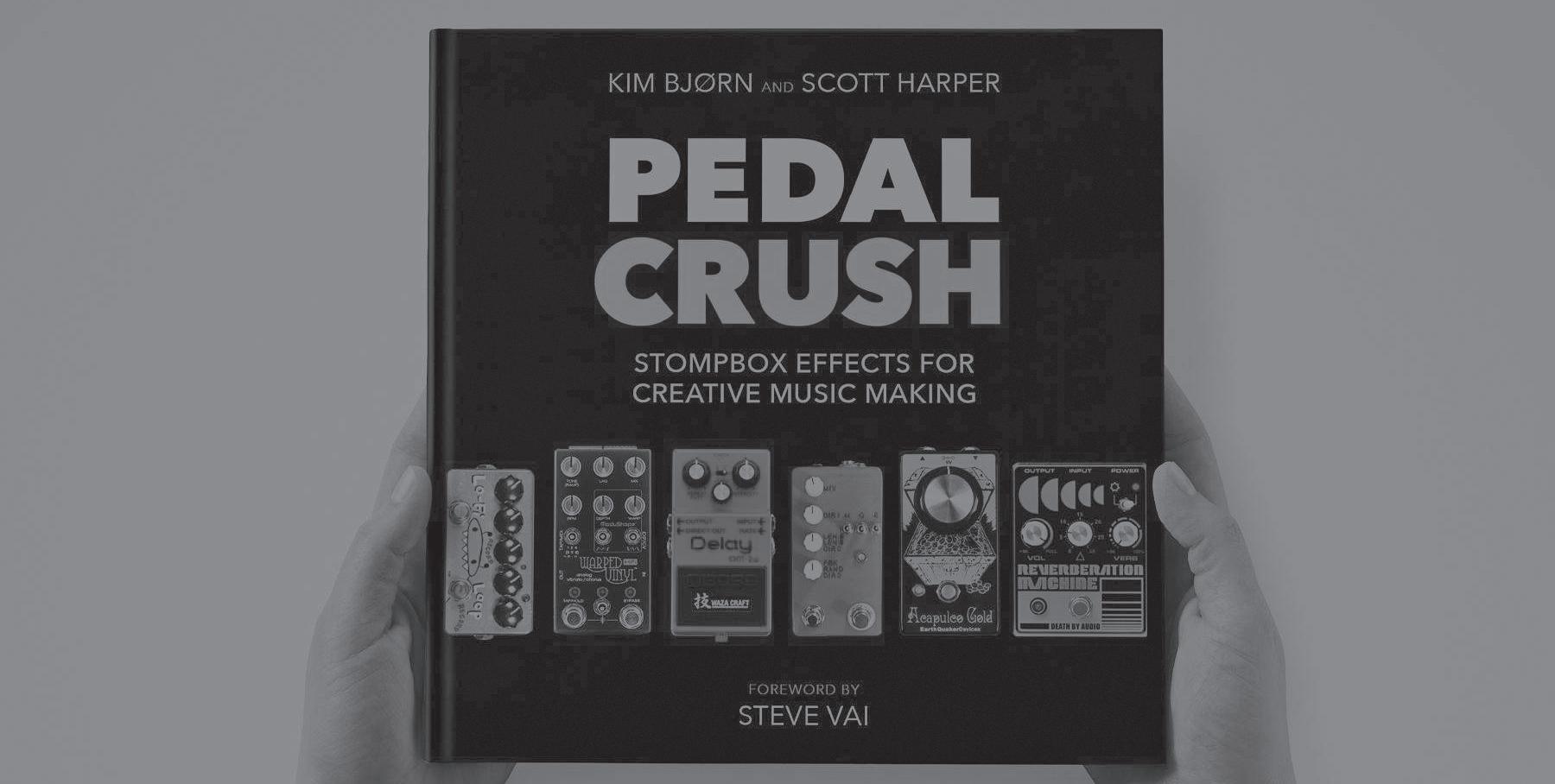


TABLE OF CONTENTS PERFORMER MAGAZINE DECEMBER/JANUARY 2023 3 VOLUME 32, ISSUE 6 DEPARTMENTS 4. LETTER FROM THE EDITOR 9. Fuzz, Overdrive & Distortion 12. How to use Chorus, Compression & Reverb 14. Those Pedal Shows 16. What is True Bypass… Really? 18. FX Loops De-Mystified 20. The Right Order for Your Pedalboard 24. Get to Know Our Mixtape Artists 32. Ultimate Pedal Buyer’s Guide 36. Favorite Pedals By State 38. Taking Your Pedalboard Wireless with Xvive 40. My Favorite Pedals: Kyle Andrews & Martin Newman 43. GEAR REVIEWS: Coppersound, Revv, Donner, Pigtronix and more… ‘Andys pedalboard’ by Rocky T is used under a CC BY 2.0 license Cover with Josh Scott from JHS HE’S GOT THE BOX 26 FEATURE STORY BOOK REVIEW: PEDAL CRUSH 5 HOW TO STACK OVERDRIVE PEDALS 10
LETTER from the editor
Hey gang, It’s here! Freak out, it’s OK. The Pedal Issue has arrived.
This one was long in the making, and we’d be remiss if we didn’t send an ultra-big hug and note of thanks to our title sponsors for the entire project, the good folks who make the Pro Co Rat Distortion pedal (and Lil’ Rat, of course). Not only did they hop on board to sponsor this issue, but also the companion mixtape.
Ah, yes! Did we mention there’s more than meets the eye this month? That’s right, we’re dropping a companion mixtape (yes, an actual cassette) featuring a number of cool artists performing original songs with a smattering (love that word!) of awesome pedals so generously donated by our sponsors.
So…keep an eye on our social channels to score a copy of the tape (it’s FREE) or give it a stream on
our Bandcamp page. Shout-outs to BAE, Ibanez, Rat, and Donner for providing the pedals we recorded with.
We hope you dig this themed issue, as we plan to do more of these in 2023, featuring various topics that you’ve told us you dig the most. But for now, sink your teeth into all things pedal-related: get to know your pedalboard order, check out some cool boxes from the obsessives at JHS, figure out your FX loop and maybe learn a thing or two about the difference between overdrives and distortions while you’re at it.
Enjoy!
Benjamin Ricci
850 Post Rd Suite 8385 Warwick, RI 02888
CONTACT
Phone: 617-627-9200 Fax: 617-627-9930
PUBLISHER William House Phone: 617-627-9919 bill@performermag.com

EDITOR Benjamin Ricci ben@performermag.com
DESIGN & ART DIRECTION
Cristian Iancu

EDITORIAL ASSISTANT Bob Dobalina editorial@performermag.com
CONTRIBUTING WRITERS
Benjamin Ricci, Chris Devine, Antonio Calvosa, Josh Scott, Kyle Andrews, Martin Newman, Taylor Tomita, Zac DelVecchio
CONTRIBUTING PHOTOGRAPHERS JHS Pedals, James Newman, Kyle Andrews, Ryan Krysiak
ADVERTISING SALES
William House Phone: 617-627-9919 bill@performermag.com
© 2023 by Performer Publications, Inc. All rights reserved. No part of this publication may be reproduced by any method whatsoever without the written permission of the publisher.
The magazine accepts no responsibility for unsolicited recordings, manuscripts, artwork or photographs and will not return such materials unless requested and accompanied by a SASE.
Annual Subscription Rate is $30 in the U.S.; $45 outside the U.S.
PS – yes, I have been watching the World Cup. And yes, as expected, something Spursy this way comes…you all know what I mean. I truly feel bad for the Three Lions, I thought this was their year, but it wasn’t meant to be. Shout out to Morocco for their achievements thus far (the tournament is still going as of press time) –it’s been exciting and truly beautiful to watch their fans and family enjoy the festivities. Brazil did…well, less than favorably, but the dancing was enjoyable while it lasted, at least. Amirite? And buh-bye to CR7’s dreams, unfortunately. Truly one obstacle after another for him this season, huh? Oh well, back to club football this month…and likely more Spursy-type things in the Champions League…
ABOUT US / Performer Magazine, a nationally distributed musician’s
publication,
on independent musicians, those unsigned and on small labels, and their success in a DIY environment. We’re dedicated to promoting lesser-known talent and being the first to introduce you to artists you should know about.
MUSIC SUBMISSIONS / We listen to everything that comes into the office. We prefer physical CDs, cassettes and vinyl over downloads. If you do not have a physical copy, send download links to editorial@performermag.com. No attachments, please. Send CDs to: Performer Magazine, Attn: Reviews, PO BOX 348, Somerville, MA 02143
CORRECTIONS / Did we make a heinous blunder, factual error or just spell your name wrong? Contact editorial@ performermag.com and let us know, cuz we’re big enough to say, “Baby, I was wrong.”
EDITORIAL SUBMISSIONS / In the words of our esteemed forefathers at CREEM: “NOBODY WHO WRITES FOR THIS RAG’S GOT ANYTHING YOU AIN’T GOT, at least in the way of credentials. There’s no reason why you shouldn’t be sending us your stuff: reviews, features, photos, recording tips, DIY advice or whatever else you have in mind that might be interesting to our readers: independent and DIY musicians. Who else do ya know who’ll publish you? We really will...ask any of our dozens of satisfied customers. Just bop it along to us to editorial@performermag.com and see what comes back your way. If you have eyes to be in print, this just might be the place. Whaddya got to lose? Whaddya got?”
4 DECEMBER/JANUARY 2023 PERFORMER MAGAZINE
EDITOR
LETTER FROM THE
Volume 32, Issue 6
trade
focuses
Chris Devine
BOOK REVIEW
Pedal Crush
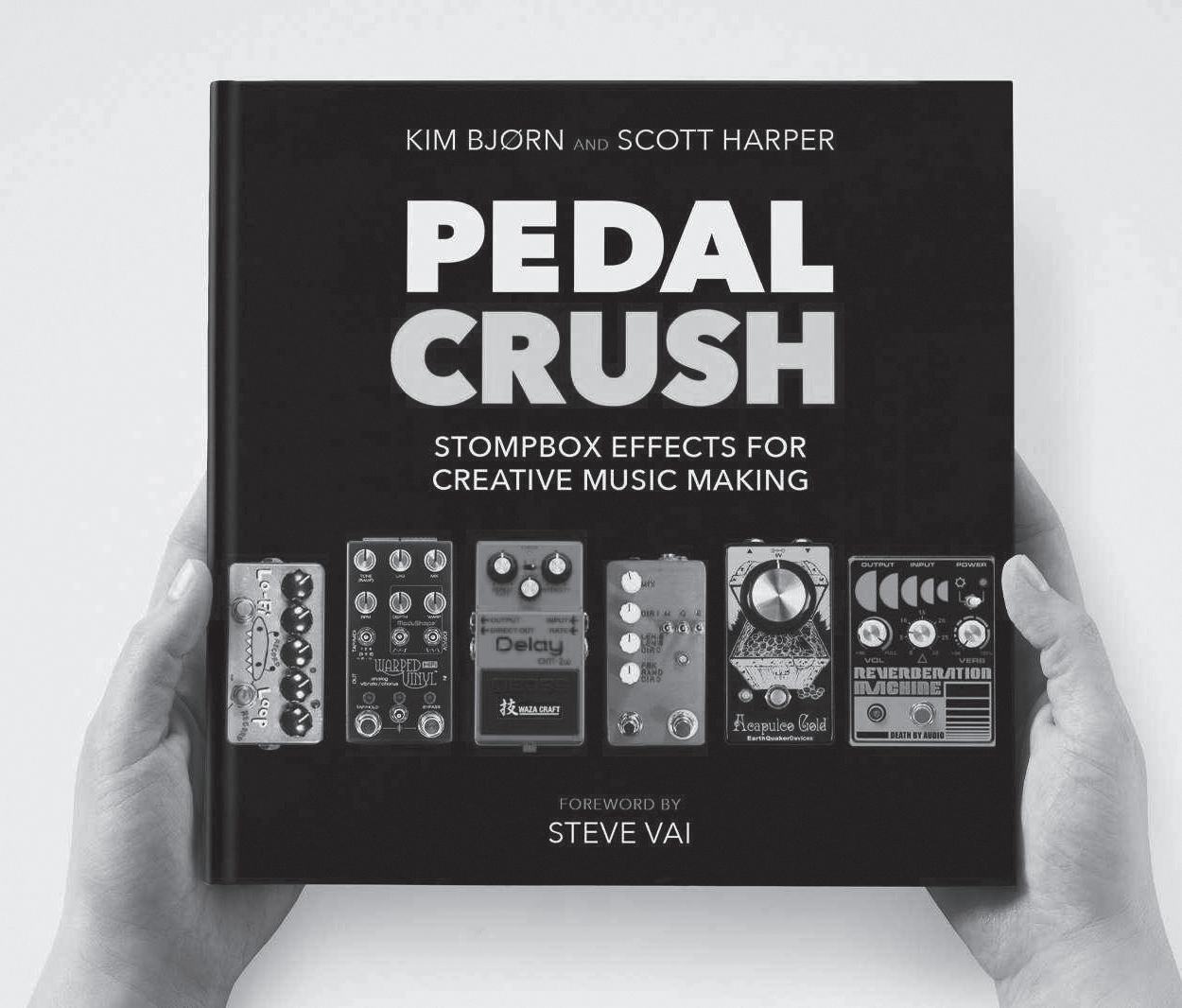 by Kim Bjorn and Scott Harper
by Kim Bjorn and Scott Harper
Guitar related books are plentiful, and many have become the respected bibles for the instruments they have covered. They’re part informational/reference items, but the glossy pictures make them interesting and inspiring to read. Considering effect pedals have really become part of the musical landscape, it’s no surprise that books on them are hitting the shelves. Pedal Crush hits all the right notes, covering information, interviews, reference, and inspiration in its pages.
Starting off, this isn’t just about pedals; while it is the focus, it also covers how pedals fit into a
player’s overall setup and sound. Ever wonder what a transistor actually does in a circuit? Well, they get into the components and their functions, but not so heavy that it’s a textbook, and not dumbed down like a Sesame Street primer, but simple, concise definitions. A complete glossary of terms is also located in the back to fully cover terms that always seem to get thrown around like “dynamic range” or even fully defined ones like “decibel.”
Ever read a pedal description and scratch your head? Yeah, this helps decode that. The resource areas also cover other pedal books, DIY books
(for the inspired pedal makers), forums, YouTube sites, and some artist and pedal makers.
The good thing with the modern wave of pedal goodness is the availability of the pedal makers, and their ability to share their backgrounds. Interviews with Josh Scott of JHS Pedals, Zachary Vex of Zvex Effects, Tom Cram of Spiral Electric FX all relay excellent stories on their journeys as makers and musicians, among other talented pedal creators. YouTubers like Andy Martin also share what they’ve learned over the years of doing hundreds of demo videos.

PERFORMER MAGAZINE DECEMBER/JANUARY 2023 5 REVIEWS
It’s quite expansive with information on multieffect units, profilers, modelers, pedalboards, power supplies, cables, amp simulation and software. But the pedals always remain the main focus. It’s not quite a complete pedal database, but does cover the most popular ones, from Boss’s DS-1 to the elusive Klon Centaur, and everything in between.
The only downside is that there’s not a comprehensive index, such as: want to see what page(s) may mention a Boss Terra Echo, or a RAT, or quickly find a mention of a Boss vibrato in the Nels Cline interview, sorry. But it is inspirational on another level, peeling through the pages and finding variations of effects, while getting a bit of an education at the same time.
Overall it’s a well-done book, with nice high-resolution images, and clear, while not overpowering explanations. Considering pedals are kind of a simple way to change an instrument’s sound, they dug in deep to show that for the player who’s become obsessed with stompboxes, it’s not a futile journey, but one that has a lot of possibilities. For the player who might get overwhelmed by the options that pedals bring, this can de-mystify a lot of aspects and make using these as practical tools more approachable in creating music.

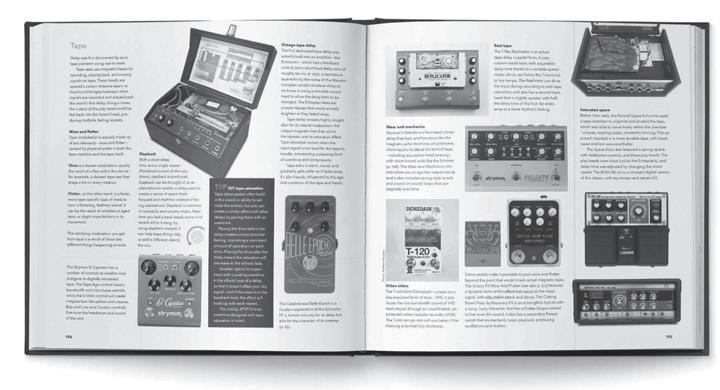
FOR MORE INFO, PLEASE VISIT https://bjooks.com

6 DECEMBER/JANUARY 2023 PERFORMER MAGAZINE
REVIEWS

New MIXTAPE OUT NOW! FREE on cassette and bandcamp!




What Are The Differences Between Fuzz, Overdrive And Distortion Pedals?
They all do the same basic thing – add harmonics and clip the audio signal. However, the sounds that they produce, and the amounts of distortion can be quite different.
OVERDRIVE GUITAR PEDALS
An overdrive guitar pedal produces enough gain to push your amp into its non-linear clipping (or distorting) level while also providing their own clipping, which is less than that of a typical distortion pedal. An overdrive pedal is used to simulate the sound of an “overdriven” guitar amp., when the tubes are being pushed beyond their limits.
In comparison to distortion, overdrive has a cleaner (but not clean) sound with usually less sustain that is more “bluesy.”
An example of this sound would be Ibanez Tube Screamer that Stevie Ray Vaughan used. You can often hear how he uses when he launches into a guitar solo.
Overdrive guitar pedals typically produce a tone that accents or enhances the sound of the guitar amp without dominating it as a distortion of fuzz pedal can. For example, the Tube Screamer can add compression and midrange tone to the sound of the guitar without overtaking original sound of the amp.
Overdrive can be seen as an effect to create sound like a cranked amp with power tubes being overdriven – not a clean sound, but not too distorted, either.
Here’s an example of some well know Overdrive guitar pedals:
Ibanez TS808 Tube Screamer
Boss OD-3
ZVex Box of Rock
DISTORTION GUITAR PEDALS
In comparison, a distortion pedal produces enough gain to push a guitar signal into a nonlinear clipping zone. This enables it to produce a distorted sound at lower levels as it does not rely on the amp also being overdriven as part of the distortion sound. The sound of these pedals can be described as a crunchy, gritty sound with lots
of sustain. It is the basic sound of most classic rock, heavy rock to metal.

Distortion guitar pedals often dominate the amps natural gain in order to produce a similar effect. For example, the Boss DS-1 tends to sound the same no matter what amp is being used.
A distortion pedal will create its own type of distortion, generally one that is not based on the sounds of an overdriven tube amp. The idea being that they distort the signal rather than trying to imitate the natural OD of the tubes themselves.
Here’s an example of some well know Distortion guitar pedals:
JHS Angry Charlie Pro Co Rat Suhr Riot
FUZZ GUITAR PEDALS
A fuzz pedal has large amounts of overdrive which is then clipped producing a near square wave. With a square wave comes the addition of almost infinite harmonics. This produces overtones and undertones maximizing the distortion being produced – hence the ‘fuzz.’
An example of the sound of a fuzz pedal would be the Maestro Fuzz-Tone used on “Satisfaction” by The Rolling Stones.
Fuzz guitar pedals could be considered to be an extreme form of distortion. However, some fuzzes will work with amps in a manner similar to overdrives (Fuzz Faces into Marshalls like those used by Jimi Hendrix), while others absolutely dominate the sound of the guitar amp like a Big Muff (think J Mascis or Billy Corgan).
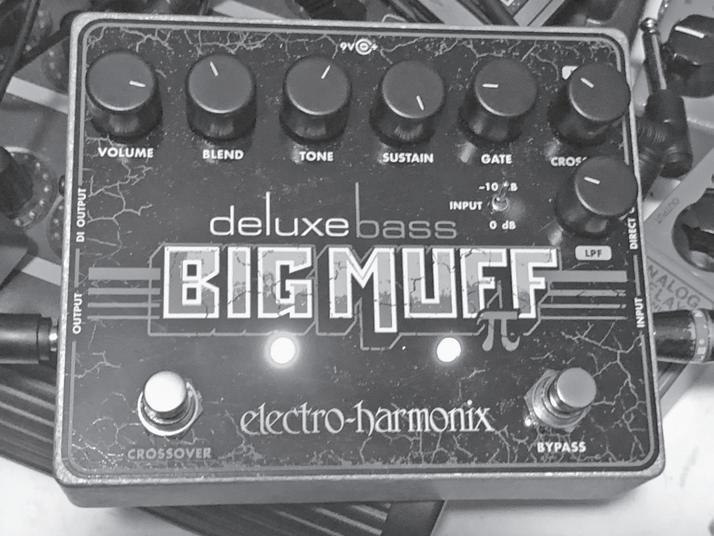
Fuzz pedals have an unmistakable sound they also can be used as an overdrive depending on if they’re being used as its own voice, or to drive or distort the amps further at lower, less aggressive settings.
Here’s an example of some well know Fuzz guitar pedals: Fuzz Face Big Muff AnalogMan Sunface
We hope this clears up a few things about the key differences between each type of pedal. Now go out there and enjoy!
PERFORMER MAGAZINE DECEMBER/JANUARY 2023 9 PEDAL TIPS
Antonio Calvosa
photo by Jacofan12609
Practical Tips and Tricks for Stacking Gain and Overdrive Pedals
Zac DelVecchio of JRAD
In the guitar world, especially when it comes to tone, everyone has an opinion on what’s “right.” However, between the blurred lines of audio science and the endless chatter of gear forums finding what’s best tonally for yourself can be a challenge.
With seemingly thousands of options for fuzzes, boosts, overdrives and distortions

finding the right setup and the correct combination for them could be the difference between a bland setup and a rig that turns heads the second you hit that first power chord.
To best understand what may work for your rig we’re going to walk through a few guidelines to help lead you to your best setup.
What’s your roadmap to tone?
The first step in proper gain staging is to understand what the ultimate overarching tone you are looking for is.
While this may seem a bit obvious, many players often want to have a board that “can do it all” when they should have a board that is for the specific gig they are on or tone in their head.

10 DECEMBER/JANUARY 2023 PERFORMER MAGAZINE PEDAL TIPS
photo by yoppy
Before considering the overdrive order and staging you must first consider what guitar and amp the pedals are going through. While there are tons of fantastic boutique brands out there, we typically see a few “parent” types of amps that have specific characteristics.
Knowing what your amp is capable of and what it cannot produce on its own is the most important part of selecting the ideal overdrives for that setup. The major parent types of amps consist of the following:*
*There will be plenty of other types of amps not mentioned here such as Trainwreck style, Dumble style, Hiwatt, etc. The groups below primarily capture the majority of amp
tones and the stacking logic will follow for any amp. The key is knowing the signature qualities the amp provides.
Marshall:
These amps, all things considered, are overall more midrange heavy, with low bottom end and pleasing highs. These amps are often used in rock styles and have plenty of gain on tap. Think Zeppelin and Van Halen
Hot Rodded Marshall:
This style of amplifier is very similar to the previous category but are often higher in gain and have tighter low end and the same quality of mids as there parent category. These type of amps are found in harder rock styles and metal. Think ’80s hair metal.
Ulta High Gain Style:
This amp type is for the most hardcore of metalheads. These amps produce insane amounts of gain and ideally tight bass response. Cue the “cookie monster vocals” for this type of amp.
Vox Style:
Amps of this style typically have chimey high end, loose midrange and bass. This amp has a jangly tone but can certainly rock with a unique heavy midrange induced drive tone. Think U2, Tom Petty and Queen.
Fender Style:
This style amp is known widely for their clean tones, excellent headroom, high highs and rounded lows. These amps also typically feature a scooped midrange
Now that we’ve gone over the major categories of amplifier types, we can discuss how drive selection comes into play.
Selecting the Drives:
The first step to a well-stacked board is to find the proper combination of pedals that will push your amp to the capabilities it cannot produce naturally. A wise selection is typically a boost and/or drive for solos and one to stack additionally for thicker leads.
Just like knowing your amp’s characteristics, drive pedals also fall under categories. They are:**
**Again, yes there are lots more categories to consider, but for the sake of a 1000-word article I tried to compress (see what I did there?) as much as I could!
Soft Clipping: Typically lower gain overdrive pedals such as the TS808 and Boss SD1
Hard Clipping: Typically higher gain pedals such as the Rat

Transparent: Typically pedals that drive your signal, but do not color the tone of your chain as much as the previously mentioned types would
Amp in a Box: Pedals that emulate the tone of amplifiers such as the Ramble Effects Marvel Drive
Place the pedals in the order of lowest gain to highest gain with the exception of fuzzes which should typically go first before the other drives in the chain.
Boosts are often subjective and it depends on your overall goal of how you wish to use it. If you are looking to use it as a true boost to the gain of your whole drive chain, then it should go before all of the other drives and fuzzes. Doing this will allow the boost to further drive each circuit after increasing the gain. This can create some scorching effects and heavy leads!
If you place the boost after the drives, it will act more as a volume boost and drive your signal harder into the amp generating a more pushed amp drive tone/lead boost.
That can sound killer, as well.
The idea behind this is to allow each pedal to behave at its best, but when stacked together they will compound on each other -- creating thicker and thicker drive until it creates a full-blown wall of sound!
Additionally, one must consider what the characteristics of each drive creates and how they will blend into each other as well as making sure the volume on each is not just at unity gain with the rig, but with each pedal. That will provide a better blend when engaging effects.
Two for One
Two-in-one pedals are often either a boost section into a drive or two drive sections cascaded together.
Thinking as outlined above a two-in-one should either go first if it is the only boost option of all your pedals being stacked or after the boost if it is a two-drive circuit.
Now that you have the basics of tone stacking have fun! Remember only you can decide what pedals and gear are right for your needs. Experiment, trust your instincts, and use your ears to create the signature tones you’ve been looking for!
For more information on JRAD pedals, please visit https://rockettpedals.com
PERFORMER MAGAZINE DECEMBER/JANUARY 2023 11 PEDAL TIPS
How To Use Chorus Pedal, Compressors & Reverb -- The Right Way!

The chorus pedal was an eighties staple, and although it’s not as common today, it’s still a valuable addition to any guitarists’ arsenal.
It’s designed as a replication of the sound of two guitarists playing the same piece –there are inevitably minor differences in pitch and timbre that lead to a choral, shimmery, choirlike sound. To produce the effect with a solo guitarist, the signal is split into two: the original
and a slightly delayed version of itself with a slight difference in pitch, which is modulated to finish off the effect. But how do you put it to best use?
CHORUS PEDAL CONTROLS
There are two common controls on a chorus pedal, “Depth” and “Rate.” The “depth” controls the amplitude (or “intensity”) of the effect, and the rate setting adjusts the speed of the
modulation. Some pedals have more controls: for example, the Boss CH-1 has settings for “Effect Level” (so you can adjust the mix of original to duplicated signal) and “EQ” (so you can adjust the brightness).
CHORUS FOR CLEAN TONES
There are two basic sounds from chorus pedals: a warm, fat chorus and a transparent, brighter one. One of the better-known examples
12 DECEMBER/JANUARY 2023 PERFORMER MAGAZINE PEDAL TIPS
Compressors
effect brings you into classic ’80s shredder territory. Again, fat or transparent chorus can work, although many players prefer a more transparent style for distorted playing. Being able to set the level and EQ is particularly beneficial to sculpting your sound when using a chorus with distortion.
So, plug in, mess around with the dials and find a sound you like! If you’re trying to choose a chorus, listen to (or ideally try out) some fatter and more transparent choruses to get an idea of which you prefer.
HOW TO USE A COMPRESSOR PEDAL
Compressor pedals are disarmingly simple –they detect spikes in your volume and normalize the levels automatically. Fattening up your tone, boosting sustain and making your sound punchier are pretty much just possible side effects of the volume controlling process. It’s all a trade-off between the desirable and undesirable side effects, so to get the most out of any given pedal you need to understand the various controls and what they do.
INPUT LEVEL
The input level control on compressors enables you to control the range of signal the pedal responds too – if you set it wrong your result will be way too noisy. If a pedal doesn’t have the control, you’ll need to use a volume control on your guitar, pre-amp or another pedal to control how loud signal going into the compressor is.
THRESHOLD
The threshold is the point where your pedal starts to actually compress your tone to control the volume. If there’s no knob, it’ll be set at a fixed amount, which you can only affect by adjusting the input level.
RATIO
This controls the amount your volume is decreased by (in dB), so a ratio of 4:1 means that once you go over your threshold, each increase of 4 dB in input is reduced to just 1 dB of additional output volume. If this isn’t available, your pedal has a fixed ratio.
Finally, some compressors only have two controls, “Compress” (or “Sustain”) and “Level.” Level is just an output control, but compress could control the ratio, threshold or other parameters like signal gain. If there are unfamiliar controls on your compressor and you can’t get the sound you want – consult the manual before giving up on compression effects!
FIVE WAYS TO USE A REVERB PEDAL

When your pedalboard real estate is limited, adding a reverb pedal might seem like the last thing you want to do. After all, it’s just a replication of something the room will do for you anyway, right? Or something you may already have on your amp. Well, reverbs can serve more like effects too, and sometimes the natural reverb of a particular room just sucks. Here are five ways to get the most out of a reverb pedal.
1. FIX A ROOM
If the room you’re playing in is dead or unpleasantly colors your tone, a great reverb pedal can be a lifesaver. Reverbs fill the void left by a dead room, and if the pedal has a hi-cut knob or a tone control, it gives you the ability to neutralize shrill overtones.
2. USE IT SUBTLY

Adding just a touch of reverb can bring a dry, unimpressive tone to life. For electric players, it gives each note a little “safety net” and some extra perceived sustain, and for acoustic guitarists a subtle splash can add some much-needed depth.
3. MODULATE YOUR REVERB
Pedals like the Strymon Flint can add modulation to your reverb, making the reverb more than just an ambience-builder. Modulated and shimmer-style reverbs still build ambience, but in a more other-worldly, ethereal fashion. Definitely something to try if you haven’t experimented with it before.
4. INCORPORATE SPRING REVERB
For a surf-inspired or borderline psychedelic sound, spring reverb capable pedals like the legendary Carl Martin Headroom offer a more unique way to add sustain to your sound.
Antonio Calvosa
of chorus on a clean tone is the intro to “Come as You Are” by Nirvana, in which Kurt Cobain used an Electro-Harmonix Small Clone to produce the warm, fat chorus sound. Many players prefer the transparent type, but you’ll have to push it to the extremes for a pronounced effect.
CHORUS FOR DISTORTED TONES
With distorted tones, the chorus
ATTACK
This controls how quickly the compressor responds to your signal and is often accompanied by a release control which governs how long it takes before the pedal stops compressing. While other controls may be missing, many compressors like the MXR Super Comp and the Boss CS-3 have this option.
OUPUT
Compression reduces your average signal level, so the output control is there to bring it up to the desired volume again.
5. CREATE A SENSE OF DEPTH
Many players used multiple delay and reverb pedals at the end of their signal chains to generate deep, blooming and lingering soundscapes. These days, thanks to advances in digital signal processing (DSP) chips, pedal makers can create stompboxes dedicated to this particular brand of reverb, like Neunaber Immerse Reverberator
There’s much more to reverbs than you might think, so dust off your reverb and get creative –and see about adding in a chorus and compressor while you’re at it!
PERFORMER MAGAZINE DECEMBER/JANUARY 2023 13 PEDAL TIPS
photo by youarenotaghost
THOSE PEDAL SHOWS
Ah yes, the tube of you. We’ve all embraced the YouTube culture in which we now find ourselves living in, and in so doing have come to find a sea of endless YouTubers hawking gear in our faces 24/7. So, who do you trust? Who do you follow? While we recommend the following shows, there’s no shortage of fun videos to watch to learn about all things pedal-related. These are just a mere smattering (second usage of smattering in this issue, do we get bonus points?) of our absolute faves you should be watching RIGHT NOW.

The JHS Pedal Show What is there left to say about JHS? Josh

Scott and crew consistently put out the most entertaining, educational and deep-diveapproved pedal content on the market. Not just a commercial for their own pedals, the JHS crew frequently looks at (and plays) their competitors latest offerings, and provides historical context for a number of well-loved pedals both past and present. If you’re getting into pedals or pedal collecting for the first time, the JHS YouTube channel should be your first stop (check out Josh’s favorite pedal boxes and ephemera elsewhere in this very issue!)
Emily Hopkins (Emily The Harpist)
And now for something completely different: a harp. Yep, that’s right, our second-favorite

14 DECEMBER/JANUARY 2023 PERFORMER MAGAZINE PEDAL TIPS
That Like
These Are Our
Smash
Button:
Fave YouTube Pedal Shows
YouTuber when it comes to pedals eschews the whole electric guitar fad altogether and puts together killer boards and pedal combinations for the harp. Whodda thunk a harpist could sound so damn amazing when filtered through stompboxes designed for the guitar community? Well, Emily’da thunkit, that’s who. And you should thunk it, too. Consistently entertaining and surprising, we can’t recommend her channel enough.

That Pedal Show
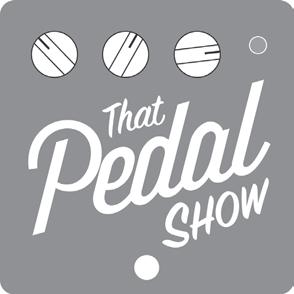
Yeah, OK we stole the title of this article from these two dashing British gentlemen. But imitation is the sincerest form of flattery, yeah? Innit? See, I did a British thing! Anyway, Daniel Steinhardt and Mick Taylor (no, not that one) host a weekly show that focuses on…well, obviously pedals or we wouldn’t be here. BUT! And this is the important bit, they actually have a lot of valuable and relatable information to share about individual pedals, pedal topics and how to put pedalboards together in the right way for YOU and your style of amp. We love the information payoff in each episode, and you should subscribe (and buy merch) if you haven’t done so. And no, they’re not paying us to say that.
Working Class Music (pictured left)
Like the title suggests, this channel is for the every-person guitar player out there. Not the guys and gals touring mega-stadiums – but the working-class musicians doing it on their own, DIY style and making their own original music on their own terms. We worked with one of the hosts, Jason Mays, on a new track for the companion mixtape to this very episode (*cough*get your FREE cassette now*cough*) and we’ll let their own words describe what they’re all about: “ Working Class Music is a music channel for Everyone and by musicians and personalities of color. We review music gear and talk to musicians about things like music, life, mental health, and the community in general. Enjoy the videos and don’t forget to subscribe to the channel so you don’t miss a single new video!”
60 Cycle Hum

Another in the more relatable category, 60 Cycle Hum is another “everyman” style YouTube show, but what it lacks in flash it makes up for in personality (and snark, and dare I say charm). Ryan Burke, then host, is just darn likeable, which makes his content just darn likeable, too, without too much cheese. While he does have his fair share of detractors and trolls (most of whom likely spend hours a day running sweep-picking exercises until their hands bleed), you just can’t help but get sucked in, especially when things (sometimes) go wrong.
Tim Pierce (pictured right)
If you want to feel bad about out your playing, Tim Pierce’s channel is a one-stop
shop to say, “Man, I’m never gonna be that smooth.” Pierce, a longtime studio and stage veteran, has probably laid down guitar tracks on about half the records you own in your collection, and his YouTube videos where he just plays and demos new gear are simply inspiring. Tim shares his industry experience and knowledge, along with AMAZING tips for how to improve your guitar playing AND tone – simple little things that just make sense and are easy to implement. Sensuously, once hour of his YouTube videos is worth more than six months of lessons at your local guitar shop, and that’s a fact, Jack.

IN CONCLUSION
Don’t forget to Like and Subscribe, and smash that notification button (the kids are still saying that, right?)
PERFORMER MAGAZINE DECEMBER/JANUARY 2023 15 PEDAL TIPS
Emily Hopkins
TRUE BYPASS
VS. BUFFERED BYPASS
 Antonio Calvosa
Antonio Calvosa
It’s impossible to shop around for effects pedals without noticing claims of “true bypass” coming from a wide range of manufacturers. Like many things in the guitar effects world, there is some disagreement about the benefits of true bypass, with some players preferring a buffered bypass to preserve their original tone. So, should you only go for “true bypass” or is there something to be said for the buffered approach?
THE DIFFERENCE BETWEEN TRUE AND BUFFERED BYPASS
The aim of the game is to preserve your tone. Simply, the more stuff you run your signal through (cables and effects pedals alike), the more your tone will degrade. For older effects pedals, even when the effect is switched off, your signal still runs through the circuitry and your tone degrades in the process, taking away from your high-end (even if just a small amount).
A “true bypass” is a mechanical switch that means your signal doesn’t travel through the circuitry when the effect is off – it just runs
straight from input to output with limited (or likely zero) impact on your tone.
Example of true bypass pedals are: the Fuzz Face, the ProCo Rat, the MXR Carbon Copy.
A “buffered bypass” on the other hand, looks at which parts of your original signal are being lost in the process and boosts it accordingly, aiming to amplify the lost parts to preserve your original signal as closely as possible. Many famous pedals use a buffered bypass, including Boss pedals, the Ibanez TS808 and the original Klon Centaur.
TRUE BYPASS: PROS AND CONS
The good thing about true bypass is that very little happens to your tone. There is no alteration and no meddling.
If you’re running a true bypass guitar pedal on batteries and they die your guitar signal will still get through when the pedal is switched off. A basic way to test if your pedal is true bypass is to remove the power source and see if you can get a
sound through it when switched off.
The only problem is that even with a true bypass, you’re adding cable length (by the very nature of connecting to a pedal) and thereby suffering (at least some) degradation in tone.
BUFFERED BYPASS: PROS AND CONS
Buffered bypass actually attempts to correct the tone issues resulting from cable length. However, since we’re used to this degradation, many players think this buffering colors their tone. Each buffer does alter your tone, and even though it may be for the better with one or two pedals, having several (especially lower-quality ones) can take away from the presence and feel of your playing.
Another disadvantage is that some vintage pedals, especially the fuzz pedals, don’t work well when you put a buffer in front of them. These pedals are specifically designed to handle a high impedance signal.
WHICH IS BEST?
The choice does come down to preference,
16 DECEMBER/JANUARY 2023 PERFORMER MAGAZINE PEDAL TIPS
but the core point is that buffering tries to rectify signal degradation whereas true bypass merely aims to avoid making it worse. If you don’t have many effects, either can work, but if you have a lot (and therefore more cable) you should seriously consider adding a buffering pedal to your chain. Lots of players will choose to add this at the end of the signal path to compensate for what comes before it in their current pedalboard order.
WHAT ABOUT HARDWIRED BYPASS GUITAR PEDALS?
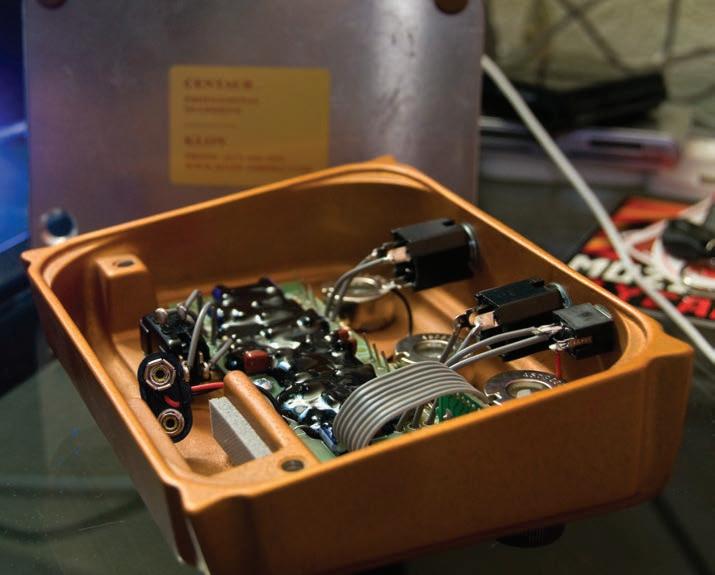
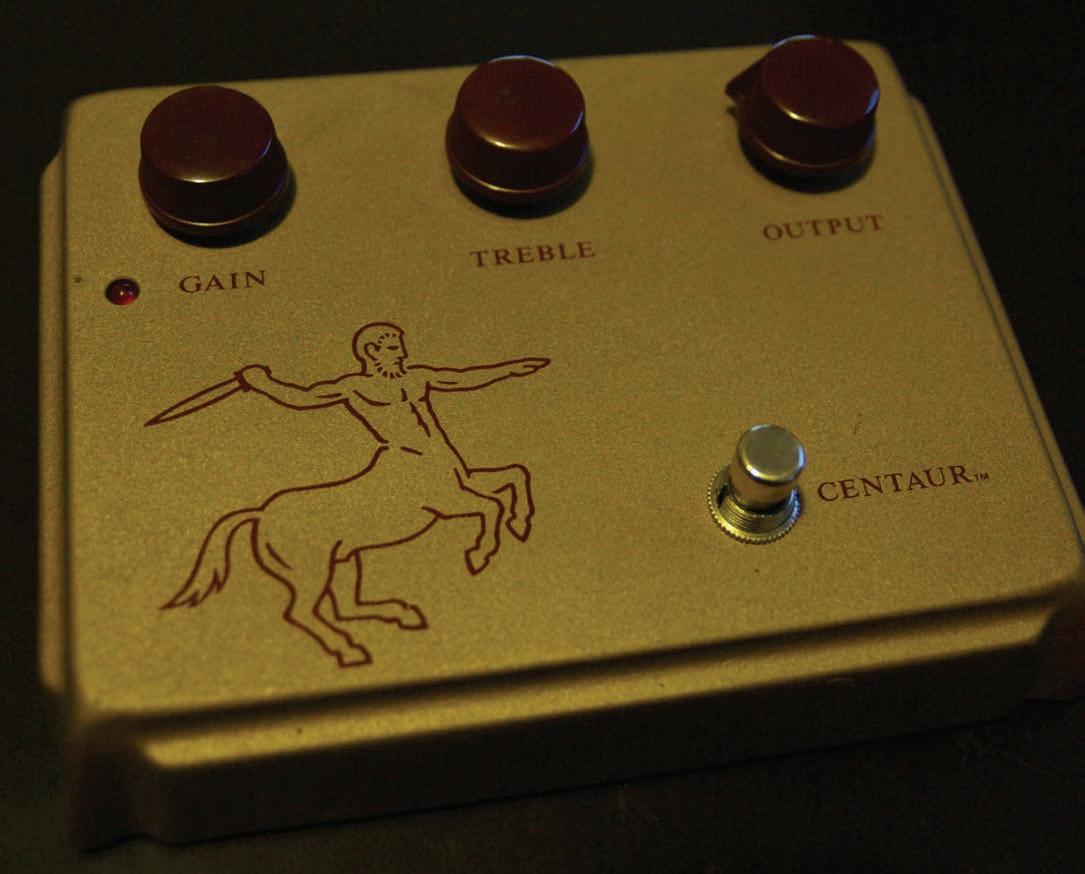
Hardwire buffered guitar pedals use a combination of true bypass and buffered bypass to pass the signal through with minimally effecting the guitar tone when switched off, but they still require power to ensure that the guitar signal passes through the pedal.
Don’t let buzzwords and forum-speak get in the way of making music – now that you know what this bypass business is all about, you can make an informed choice on how to select the best pedals for your particular board, and how to order them for the best signal possible.
PERFORMER MAGAZINE DECEMBER/JANUARY 2023 17 PEDAL TIPS
photo by ArtBrom
photo by aaronHwarren
Unlock Better Tonal Possibilities
FX Loops and You
Unlock Better Tonal Possibilities

What is an effects loop, you may ask? Well, it’s an “opening” on an amp allowing effects to be run after the preamp, and before the power amp section. When effects are connected in this manner, the amp’s preamp distortion/gain comes first, THEN the effects, then the power amp brings the overall volume. Typically, the kinds of effects that work best in an amps effects loop are time based: modulations, delays and reverbs. Tonebased effects like drives, EQ’s and wah pedals generally don’t sound great in this application,
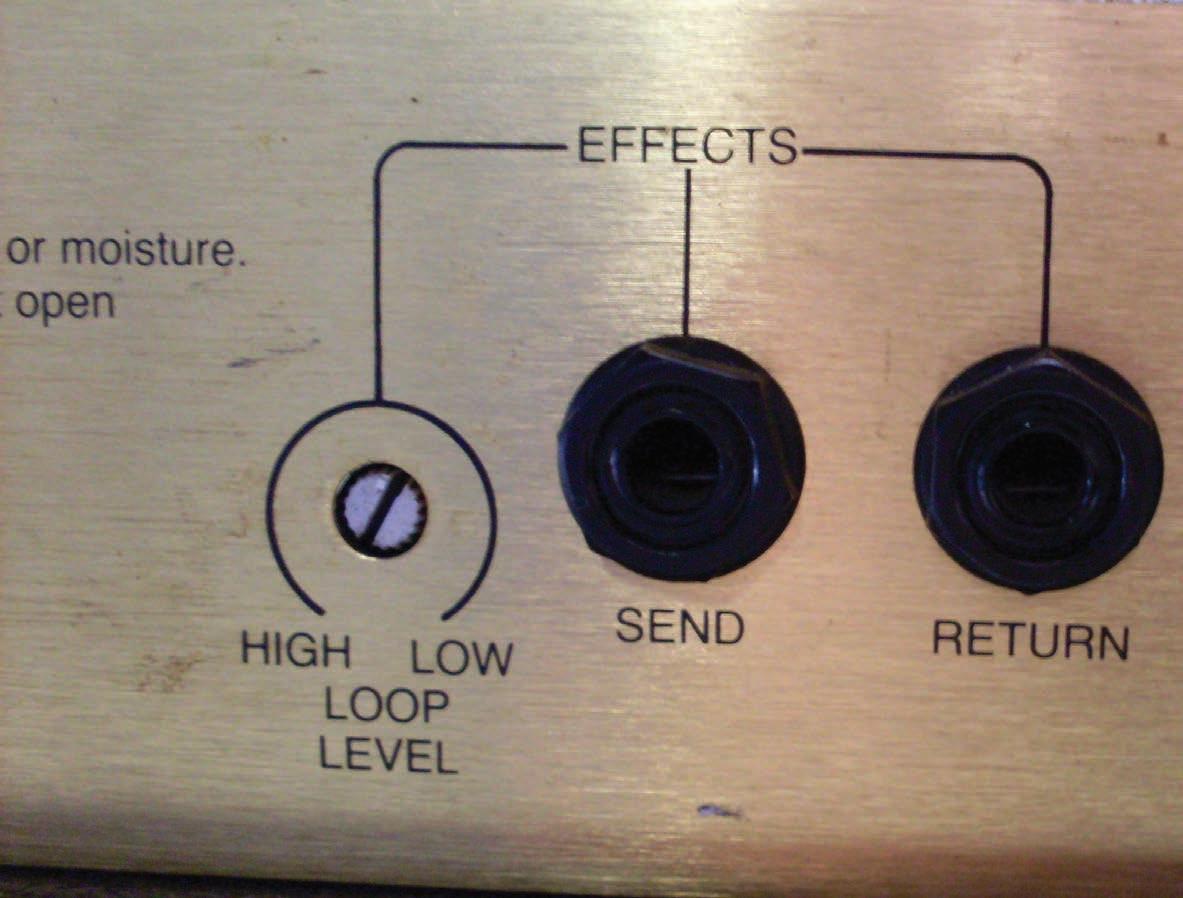
and running these in front of an amp will sound better nine times out of ten.
A typical guitar rig runs stompboxes in front of an amp, and that makes sense. However, if that amp is doing all the drive and distortion sounds, running things like reverbs, delays and choruses into an amp that’s overdriven or distorted already can make for a pretty muddy tone. Yes, this is how it was in the old days, and no one had any issue with Eddie Van Halen running an Echoplex, Flanger or Phase 90 into the front of his overdriven Marshall, but when Mr. Van Halen designed his 5150 amps, he wanted an effects
loop for his time-based effects; EVH knew the benefits of this modern feature.
Some multi-effect pedals like Boss’s GT-1000 have a “four cable method” that can run the timebased effects in through an effects loop, while the drives, EQs and such can be run into the front end of the amp. There are guitar interface boxes made by companies like Vertex Effects, as well as Schmidt Array, that allow a stompbox-based pedalboard to work with the four cable method when desired, and work without one when that situation is happening. So, if you’re backlining and requested a Fender Hot Rod Deluxe (which
18 DECEMBER/JANUARY 2023 PERFORMER MAGAZINE GEAR
Chris Devine
has an effects loop) and you get a Fender Deluxe Reverb (which has no effects loop) you’ll be set either way.
Just as not all amps are created equal, nor are all effect loops. Some amps typically are meant to run line level effects such as rack units, not instrument level effects, like pedals. Thankfully many amp manufacturers understand the overwhelming presence of pedals and have set up their effects loops to work with stomp boxes, or are selectable for line or instrument level effects.
The effect loop is also sometimes labeled “preamp out” and “power amp in” on an amplifier’s panel. A great way to use this is running a line from the preamp out to an external power amp, for providing more power to run extra guitar cabinets. The power amp in connection can also be used to “hijack” an amp’s power amp section. Plugging a guitar into a pedal that’s connected to the power amp in section can bypass the preamp altogether

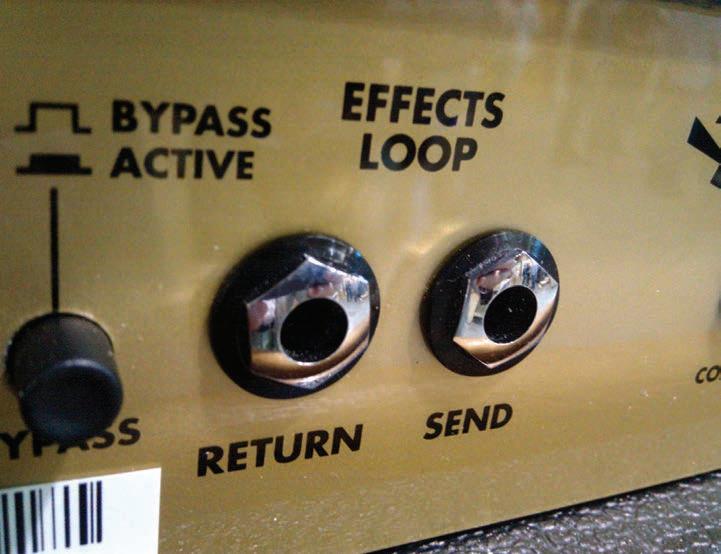
and re-define the sound entirely on the pedal.
Plugging in a pedal like a TS9 or a Boss DS-1 may not be desirable, as while these pedals are “preamps,” the tone adjustment is limited. A better option would be a true pedal preamp, like one of Revv’s G Series pedals or one of Origin Effect’s preamp units.
As we mentioned the Fender Hot Rod Deluxe previously, these are great amps, perfect as a pedal platform, however these are a VERY loud 40Watts. Having the volume level on 3 can deafen a drummer in a practice room, so never mind getting an amp tone that’s at a reasonable volume. BUT there is a solution, running a resistive load in the effects loop. What’s a resistive load you say? Well, a simple resistor, such as a potentiometer (an adjustable resistor) can do that. There are schematics online as to how to make one with an enclosure, a couple of 1/4” jacks, some wire and a pot, or for simplicity (and peace of mind) JHS has a device called a lil Black Box that can be connected to an effects loop with some patch cables, and this acts as a “master-master volume control.” Get your amp sounding as you like it and use the knob on the device to attenuate the volume level so as to not destroy your bandmate’s hearing. It’s a safe way to tame a tube amp with no modifications.
As always, read your manual before plugging stuff into and out of your amp’s effects loop. Your mileage may vary, but it’s an option that often gets overlooked, and could help your overall guitar sound with just a few adjustments to your existing rig. Adding modulation and time-based effects simply sound better AFTER the preamp in almost all situations, but please feel free to experiment and add fx in your signal chain to taste.
PERFORMER MAGAZINE DECEMBER/JANUARY 2023 19 GEAR


20 DECEMBER/JANUARY 2023 PERFORMER MAGAZINE GEAR What’s The Best Order For YOUR Pedalboard?
Benjamin Ricci
With the recent re-launch of the Maestro brand from Gibson, we thought it would be fun to take a look at the entire lineup of pedals, evaluate each one, and review them. So, we’re doing that…just not in this issue. Check out the website or one of our earlier 2022 issues for that.
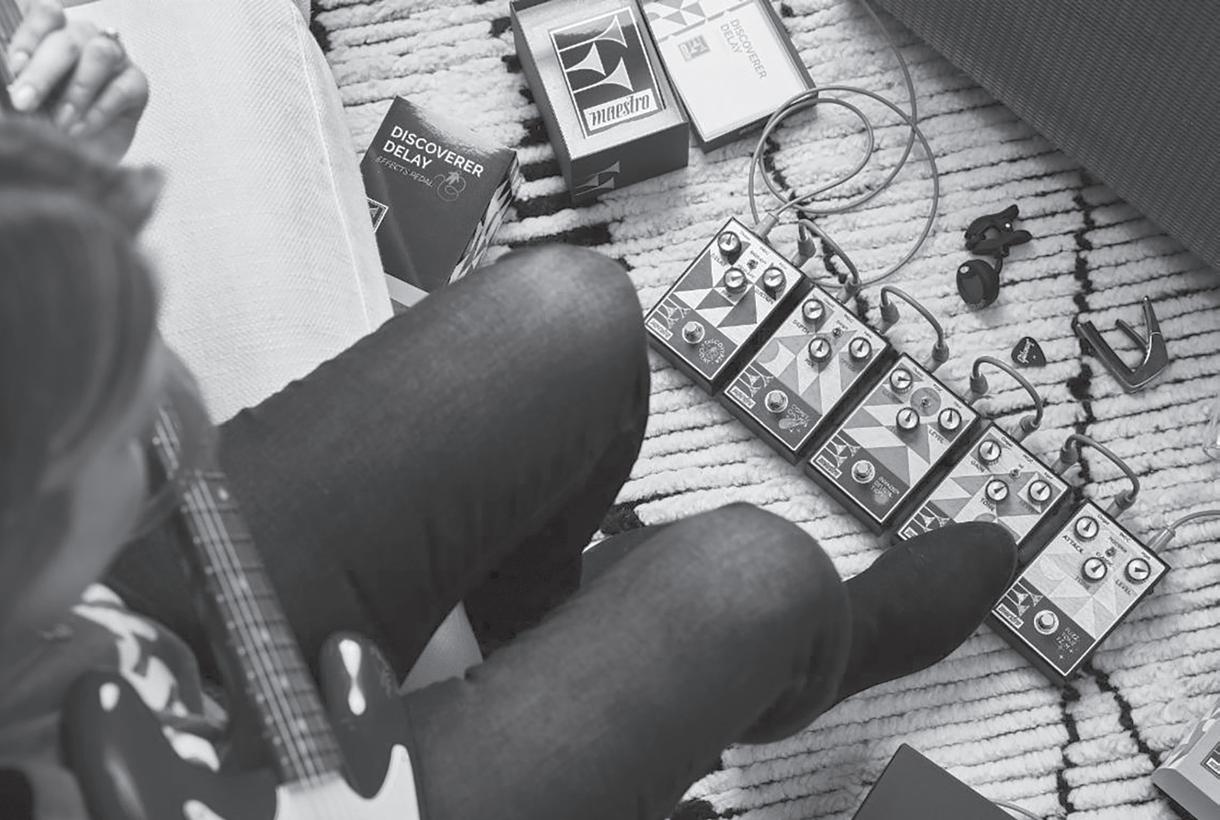
But it got us thinking – Maestro’s got a new fuzz, drive, distortion, chorus and delay out now, so which order should we put them in on our pedalboard? Does it matter? Should we throw caution to the wind, be true renegades and put modulation stompboxes *gasp* in front of the amp and not the dedicated fx loop on the rear?
These questions and more will be answered… now.
What’s an FX Loop, Anyway?
Good question, and the first we plan on answering! If you have a decent amp, you may have noticed some jacks on the back collecting dust. Those, dear readers, are likely your fx loops, looking sad and unused. That’s because most of us neanderthal guitar plays just slap everything in front of the amp in whatever random order chaos theory has dictated, crank everything to 10, and then go on internet forums seven to ten minutes later to complain that we’re not getting the “tonez.”
So, the FX loop was meant to take timebased effects, like the killer new Discoverer Delay and Comet Chorus from Maestro (we’re obsessed with this chorus, btw) and put them where they belong. Out of sight! No, that’s not true. Out from in front of the amp, away from those nasty, nasty drives, distortions, fuzzes and otherwise messy-sounding units that gunk up your modulation effects. And who wants that?
Well, we do…sometimes. You see, kids, rules are meant to be broken. And in the world of rock and roll, both ways of doing things – the “right way” or otherwise – are perfectly valid. Try it yourself; we will say we oftentimes *prefer* putting modulation pedals in front of the amp because sometimes FX loops do funny things with volume dips, and sometimes the way a gnarly distortion box affects a wobbly chorus effect is KILLER.
And sometimes not, in which case you put that pesky chorus or reverb right back where it belongs! Loop! Loop! Loop!
That said, do show your under-appreciated fx loop some love, and give it a go. If you like a touch of delay or reverb, throw ‘em in the loop and you might just clean up the “tonez” that those forumdwellers couldn’t help you with.
BACK to the FRONT!
OK, so we’ve touched upon the oft-neglected and unloved loop situation. Now, the good stuff. The front of the amp is where your drive, fuzzes, and distortion pedals should live. They just sound better that way, trust us. Go ahead…waste 5 minutes putting them in the fx loop just to prove us wrong…we’ll wait.
You’re back? It wasn’t what you hoped for, was it? Ahem, as we were saying, the front of the amp is where the majority of your stompboxes will plug into. Hitting a drive pedal hard going into the front of a classic amp is just pure bliss, so why mess with success? Oh yeah, we said something earlier about breaking rules and whatnot. Well, sometimes rules are there for a reason!
Moving on…
What’s That Order, Again?
So, let’s look at the order that usually works the best when it comes to your pedalboard, going straight into the front of the amp.
We recommend something like this, but your mileage may vary (hey, it’s a free article, what do you expect?)
Volume, Expression and Dynamics
Typically, taming volume and dynamics
PERFORMER MAGAZINE DECEMBER/JANUARY 2023 21 GEAR
just sounds best front and center, ESPECIALLY compressors. When you’re adding compression to a guitar signal, you’re balancing out the highs and lows in the volume range, which can even out the signal. You hear this a lot in country music, sure, but it’s super useful even in indie rock (some of you really should take more advantage of compressors, trust us). This type of effect should be applied near the beginning of the signal, and while you’re at it, we recommend throwing your volume or expression pedals here, as well.
Volume pedals, we feel, work best here because you can utilize it as a way to clean up or roll off a harsh signal before it hits your other fx and gets too muddy or blown-out. It’s just one way of doing it, of course, you could always experiment with it at the end, which some companies recommend so that you can control the entire signal, affected or not, before smashing into your time-based effects (hey, remember those!)
Turn The Gain Down a Tad, Skid Row
That’s an old joke from a comedy bit we barely remember, but it leads us nicely (or not, if you’re gonna be critical about our segues) into the next batch-o’-fx that should get wired into your pedalboard. We’re talking the Metal Zone, and ONLY the Metal Zone! Mwuah haha!
No, seriously, your drives and distortions should probably go here. Anything but the Metal Zone – something, perhaps, like the brandspanking new re-imagining of the classic Maestro Fuzz, the FZ-M? If you haven’t been living under a rock like us, you’ll no doubt recognize the
legendary, original Maestro Fuzz pedal from such classics as “Satisfaction” and about a million other tracks that brought fuzz to the mainstream.
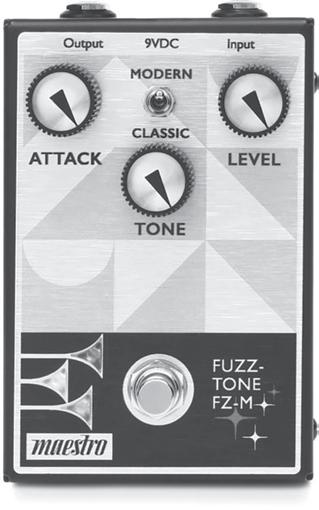

So, if you, like us, want to get your fuzz on, pop it in the chain here. Or, for more saturated lead sounds without the wooliness, try slotting in an overdrive like the Maestro Ranger, or even take an extended holiday to Saturation Village with the Maestro Invader Distortion pedal.
Levity aside, we have been playing with these new Maestro stompboxes for a few weeks, and they’ve all been awesome additions to our pedalboard arsenal. We also dig the fact that they’re not coming in at boutique prices, either. Have you seen what Klons and Klon Klones are fetching on Reverb these days?
Anyway, back to the matter at hand. You’ve got your foot rocking the volume pedal, your other foot smashing the drive on full blast, and your third foot ready to engage the… the what?
Time Has Come Today…
Yes, your old friends the Time Bandits! You remember, the collection of time-based effects we previously tossed into the void that is the fx loop: chorus, delay, phasers, oh my!
Gain it up first, then time-squelch it later, I always say. And that formula seems to work well. Keeps things clean -- it’s easy to remember, and you’ll hardly every go wrong.
If you have a wah, and you’re not named Saul or Kirk, this might be the best way to wrap-up
your pedalboard’s layout. For some reason that smarter people than us can explain, wahs work at their best while sweeping through frequencies (basically acting like a big filter knob on an analog synth) AFTER all your other pedals are doing their business. This is especially true if you’re throwing gain in front of the wah, which is how we like it, and you likely will, too.
There are many more types of effects out there, some incredibly esoteric and expensive, that we won’t be covering here. But these are the main players, the heavy hitters, the stalwarts of the fx ecosystem that you’ll generally be encountering on your tone journey.
With a little forethought, some Velcro and a power supply, you too can whip just about any unwieldy pedalboard into ship-shape in no time.
And with that, we must bid you adieu. Until next time, friends, keep smiling, keep stomping, knowing you can always count on us…to not take these things *too* seriously.
Guitar pedals should be fun, so for crying out loud, have fun with it. And send us what you come up with, we want to feature independent artists like YOU in each and every issue. Who knows, one day your weirdo pedalboard and it’s super-odd ordering of stompboxes could grace these pages and prove us, and the industry, wronger than wrong!
Before you go, though, do check out the new lineup of Maestro pedals and learn a little about their history, while you’re at it, all at https:// www.maestroelectronics.com
22 DECEMBER/JANUARY 2023 PERFORMER MAGAZINE GEAR
coming soon to


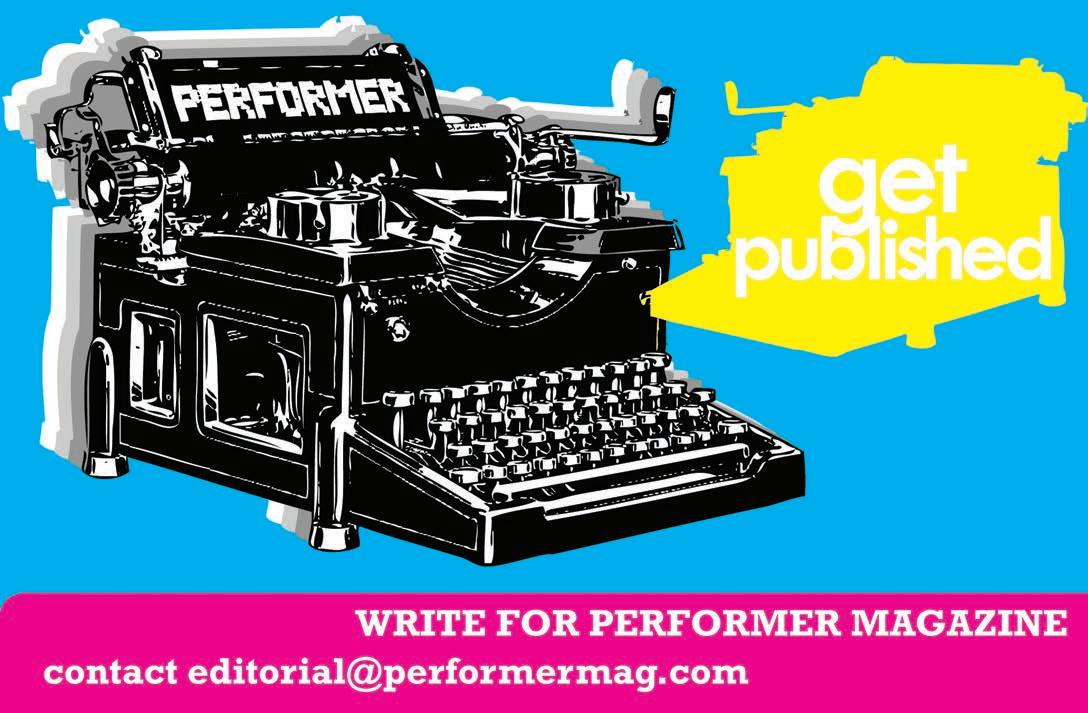
PERFORMER MAGAZINE DECEMBER/JANUARY 2023 23
VINYL! from
Get to know the artists on the Pedal Issue Companion cassette Meet Your Mixtape
That’s right, we’re not just putting out a special Pedal Issue (*cough*you’re holding it now*cough*), we’re also showcasing how cool some of our favorite pedals sound by putting them in the hands of seasoned pros, and letting them rip on exclusive tracks for a companion mixtape we’re putting out in conjunction with the issue.
That’s right, an actual cassette! Don’t worry if you don’t have a tape deck, it’s streaming on Bandcamp
for FREE (the tape’s free, as well) so you can listen on your device of choice. We want to thank our premier title sponsor the RAT Pedal (specifically the Lil’ RAT) as well as the other companies who’ve donated pedals for the project: Ibanez, Donner and BAE. Without them, none of this would be possible!
We also want to thank our very special retail sponsor for the issue and the mixtape: Guitar FX Direct – find them online at http:// www.guitarfxdirect.com. Guitar FX Direct is
an online retailer of boutique guitar effects pedals that ships worldwide. They partner with manufacturers who are passionate about producing pedals that are designed both to sound great, and not compromise on materials, quality, and craftsmanship. Whether seeking your first pedal or completing your board, Guitar FX Direct is on hand to help you find YOUR sound.
Now, let’s meet the artists who’ve recorded brand-new tracks for the compilation, shall we?

Version
Eight
Shrouded in mystery (and perhaps hailing from the wintery depths of Minnesota), V8 is an absolute master of all things that come with six (and more) strings. His eyes also glow with the fire of a thousand frets whenever sweep picking is nigh.
Follow on Instagram @versioneight
Ando San

Another multi-scale master, Ando San has perfected the art of thumping on his killer Ormsby guitars. Legend has it if you corner him at NAMM, he will whisper the secrets of the thump (and the mysteries of the universe) gently into your ear…
Follow on Instagram @ando__san
Abigail Zachko
No stranger to fretboard sorcery and mysticism herself, Zachko has dazzled and boggled minds the world over with her fingerboard mastery and wizardry. Just don’t look her straight in the eyes, else your mahogany-bound neck will turn to stone.
Follow on Instagram @abigailzak
Baxter Hall
Boston native Baxter Hall has an old soul, and even older guitars. Relishing all things vintage, just close your eyes and be transported to a simpler time when amps had one knob, and we liked it that way, dagnubbit!





Follow on Instagram @_baxterhall_
Jason Mays
One of the brains behind the excellent Working Class Music YouTube channel, Mays and Co. deliver real-world reviews, by real-world people, for real-world applications featuring all the gear you wish you had your grubby little paws on in the real world.
Follow on Instagram @jasontmays
Kal the Guitar Hero
Kal, formerly the slayer of thots, has risen through the ranks to earn the title of Kal The Guitar Hero, having dethroned the previous title holder in a footrace through the arid deserts of the American Southwest, possibly part of a Road Rules Challenge. The details are murky, at best…
Follow on Instagram @kal.the.guitar.hero
PEDAL MIXTAPE
LISTEN TO THE companion mixtape!

out
now on cassette and on bandcamp

26 DECEMBER/JANUARY 2023 PERFORMER MAGAZINE SPOTLIGHT
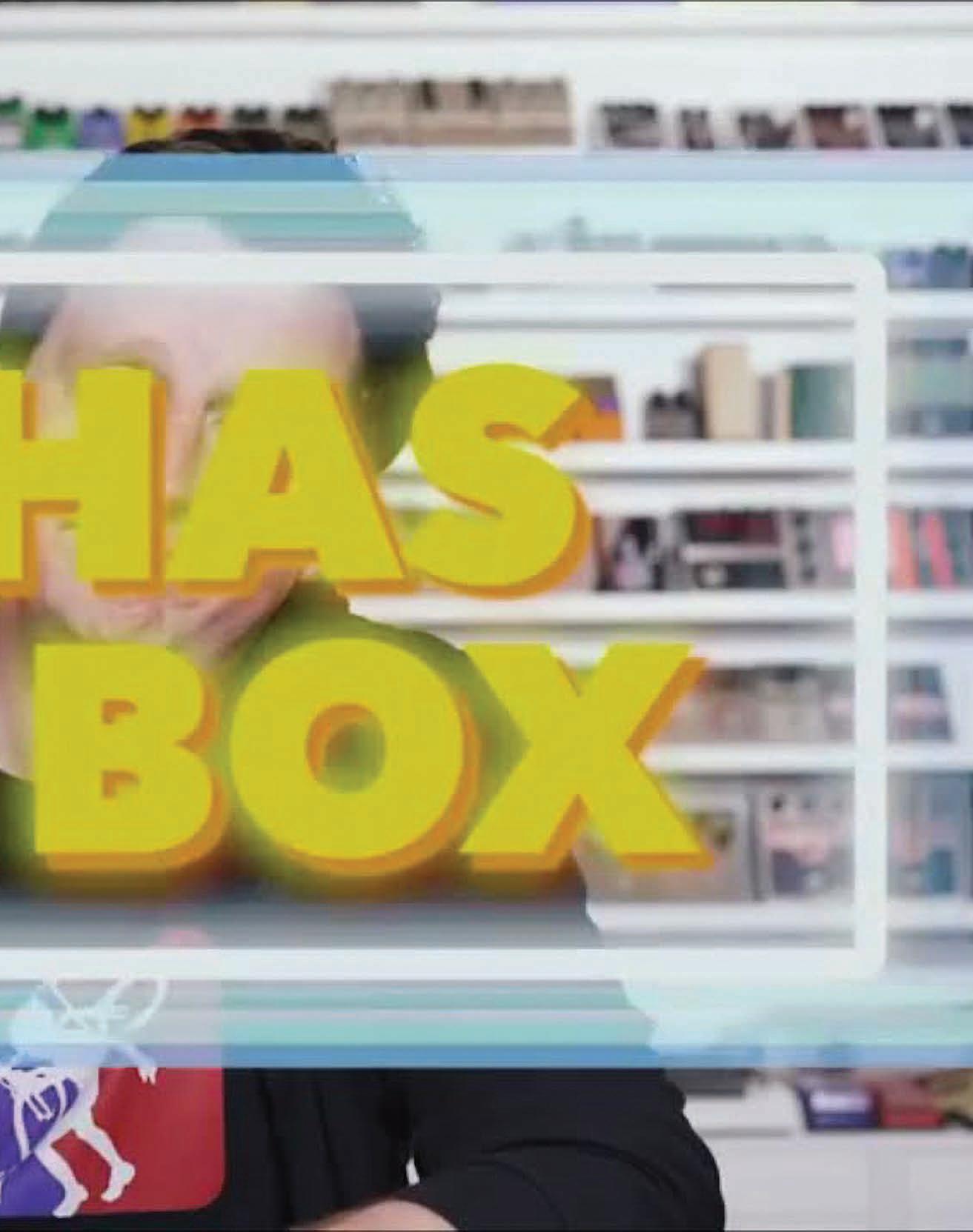

PERFORMER MAGAZINE DECEMBER/JANUARY 2023 27 SPOTLIGHT A Look at Unique, Cool and Memorable Pedal Box Art Design with Josh Scott from JHS Pedals
SPOTLIGHT
Editor’s note – we love JHS Pedals, and we scramble to our phones whenever the notification bells dings each time a new JHS video hits YouTube. One of our favorite bits they do is called “He Has The Box,” in which founder/owner/ all-around-good-guy Josh Scott shows off and waxes philosophical about the box a vintage or unique pedal came in. Oftentimes, there’s more to say about the box design and artwork than the pedal itself. So, with that in mind, we asked Josh to show off some of the neatest boxes in his ever-growing collection. Can’t you just smell the cardboard through these pages?

same year). The most notable user was Eric Johnson, who utilized it early in his career.
Dallas Arbiter Trem Face: Everyone knows about the Fuzz Face, but the Trem Face was a tremolo that Arbiter made during the same era (the late 1960s). The enclosure is identical to the Fuzz Face; coincidentally, these boxes are almost impossible to find.


28 DECEMBER/JANUARY 2023 PERFORMER MAGAZINE
Marshall Supa Fuzz: This pedal is a version of the Tone Bender that was made by Sola Sound in the 1960s for Marshall; this specific version was released in 1968. This is one of the few fuzz pedals that we can confirm Jimi Hendrix used, other than the Fuzz Face.
Seamoon Fresh Fuzz: This was a strange distortion/fuzz pedal released in 1973 and manufactured in Berkley, CA. It was the second-ever pedal produced by Seamoon (the first was the Funk Machine envelope filter released earlier the
Univox Super Fuzz: The Super Fuzz is the most iconic octave fuzz ever made and this particular version and box is from the early 1970s. This box features some of my favorite art and branding of all time.

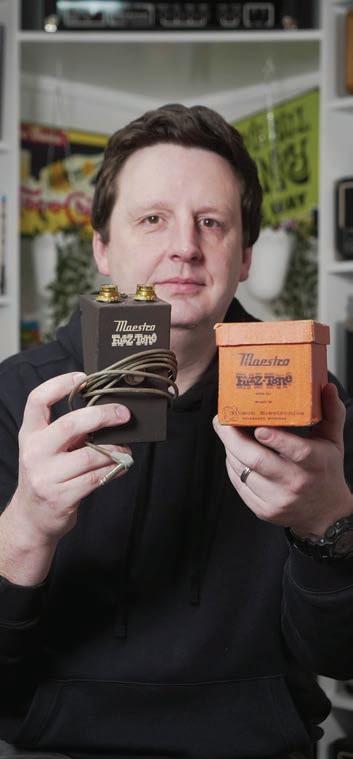
DeArmond 601 Tremolo Control Unit: This was the first ever standalone guitar effect unit released in 1947, made in Toledo, OH, by DeArmond. DeArmond was a massively influential company in early electric guitar history, especially with the DeArmond magnetic pickup which was created using the parts of the Model T Ford. The tremolo effect is produced by conductive fluid being propelled in a bean can-sized container inside the enclosure– not an ideal feature for a product that’s meant to be plugged into an electrical outlet.

PERFORMER MAGAZINE DECEMBER/JANUARY 2023 29 SPOTLIGHT
Maestro Fuzz-Tone FZ-1: The FZ-1 was the first guitar pedal ever made, released in 1962, which means that this is the first guitar pedal box. The OG, if you will.
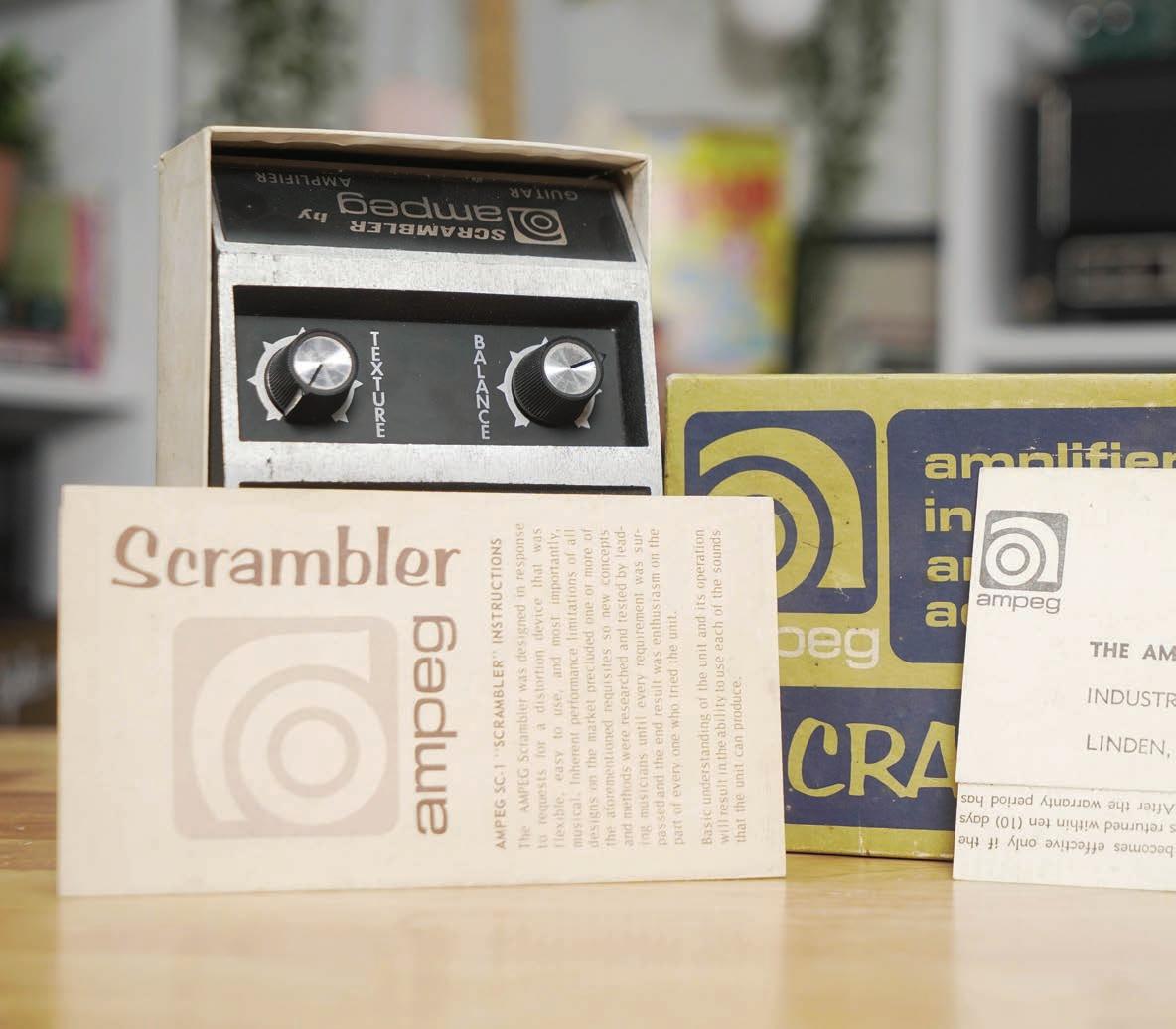
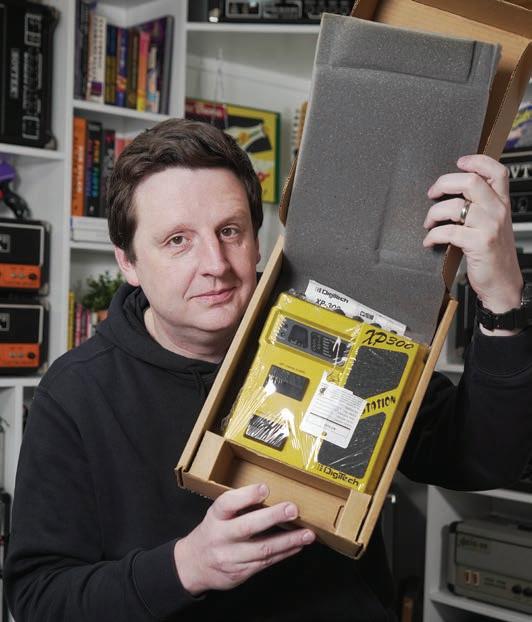
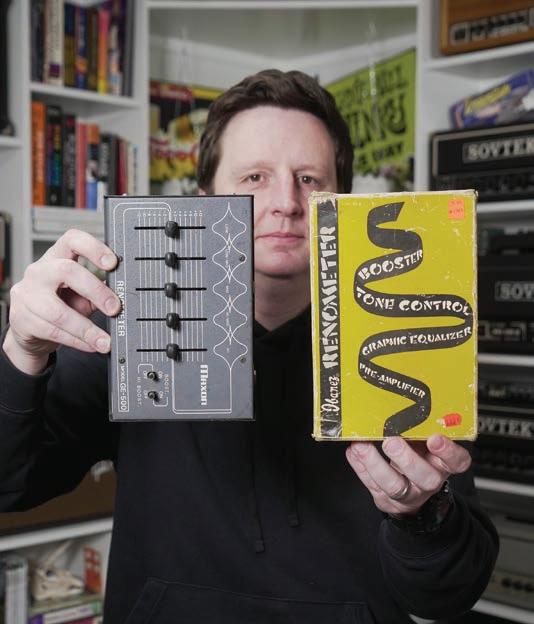
SPOTLIGHT
Ampeg Scrambler: The Ampeg Scrambler is an octave fuzz from the late 1960s, and is one of the first gooped pedals, meaning that the circuit inside the pedal is covered in a black epoxy mixture. My favorite use of this pedal is by the band Cactus on their self-titled debut album.
Digitech Space Station XP300: The box itself isn’t anything to write home about, until you open it and realize that it houses an original, still-in-the-plastic-wrap, never-been-used Space Station from the late 1990s. Truly out of this world.
Maxon Renometer: The Renometer was released in the mid-1970s and manufactured in Japan. While these pedals– and their amazing boxes –were produced by Maxon, they were made for and marketed by Ibanez as well. As a result, you have a pedal labeled “Maxon” in a box that says “Ibanez,” and both are technically correct.
BONUS:
One of the cooler things about collecting boxes and attaching them to the pedals is that you find ephemera that was supposed to be thrown away– things like hang tags, phone numbers, business cards, sales receipts, warranty forms, addresses to the company headquarters, all kinds of crazy stuff. That’s one of the best parts of pedal collecting, and it also allows you to accurately date the product. The original instructions can also provide useful insight into how weird the world was and how people utilized this kind of guitar effect when it was released.
Basically, the boxes are cooler than the pedals, but the ephemera are cooler than the boxes.

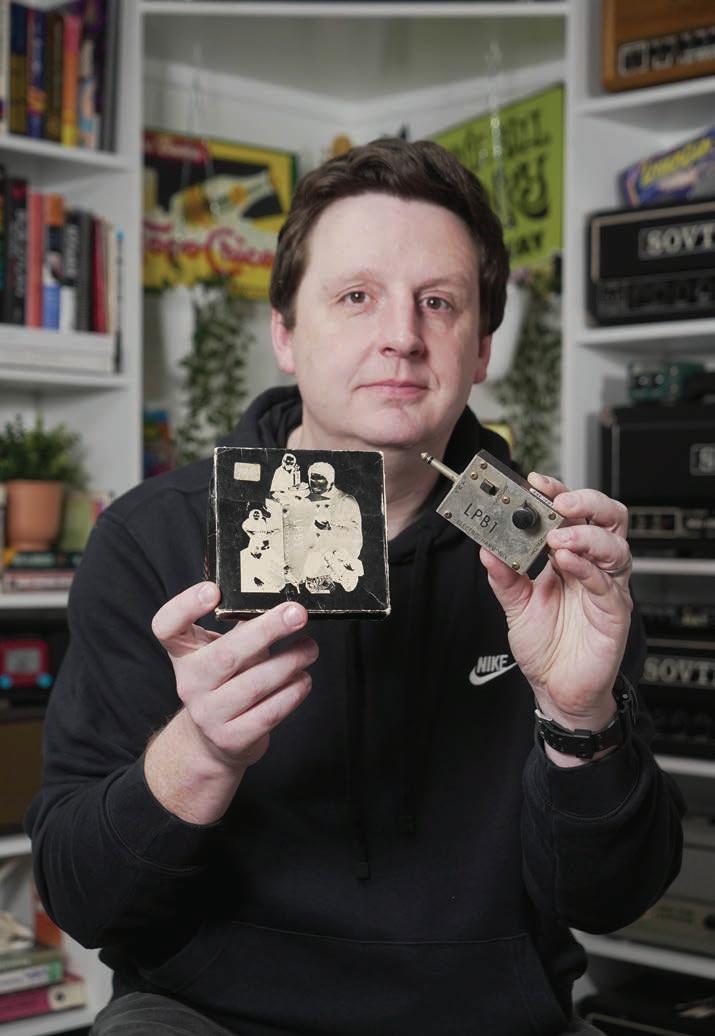
For more info, be sure to follow JHS on YouTube and at http://jhspedals.info
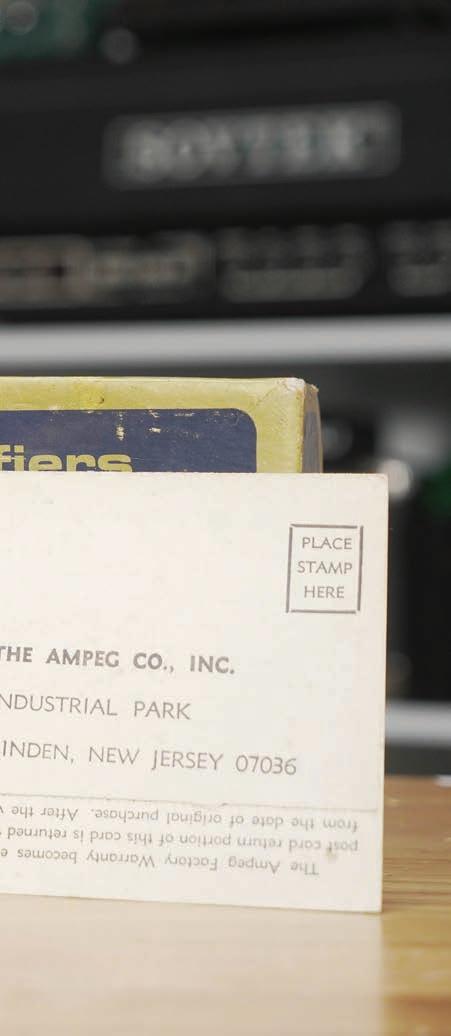
PERFORMER MAGAZINE DECEMBER/JANUARY 2023 31 SPOTLIGHT
Electro-Harmonix LPB-1: The LPB-1 (Linear Power Booster) was originally released in 1968. The cheese wedge-shaped box is decorated with a homemade photo montage featuring a young Mike Matthews and friends holding a giant LPB-1.
Dan Armstrong Musictronics Series: I’ll admit this is a little bit of a cheat, as I chose a large store display box that holds the full set of Musictronics Dan Armstrong plug-in effects released around 1975: the Blue Clipper (which may be the first op-amp overdrive ever made), the Orange Squeezer (my all-time-favorite compression pedal), the Purple Peaker, the Red Ranger, the Green Ringer and the Yellow Humper. I’m a sucker for this line and its aesthetic.
GEAR
THE ULTIMATE BUYER’S GUIDE
K, pedal newb, listen up! Making music should be fun! So don’t let any jaded a-holes talk down to you, and especially don’t let anyone call you ‘newb’ – even us. It’s rude and gatekeeping in music is stupid and childish.
Anyway, let’s talk PEDALS! Let’s say you are starting from scratch and want to hit each and every effect category, so you are never without that crucial stompbox when inspiration strikes. I mean, who knows when you’ll want to flange the heck out of that rippin’ lead, amirite? What are our top picks for each fx category? Well, glad you asked. We put together this very article to address that question.
Now, while this will generally follow the order in which pedals typically go on a board, there are no rules when it comes to pedal placement, just use your judgement (and ears) to put things where they fit and sound best in YOUR chain. That said, we do have some tips on using your amp’s fx loop and the best order for fx elsewhere in the issue, so do check those out. Without further ado, the envelope please…
The Pedalboard Don’t be a lazy slob and just plop your pedals on the floor. It’s messy, dumb and makes setups and teardowns a nightmare. Get yourself a decent pedalboard with MORE SPACE THAN
Oas their boards are rugged, durable and the slatbased layout makes cable routing and power management super easy. We’ve opted for the mega-king-sized Classic Pro because it comes with all the room we need for our ridiculous set up, plus an awesome flight case with compartments for our cables and accessories.
Now, if you’re doing a small fly-in date and don’t want to lug this stuff on the plane, you can opt for one of their various other sized boards, there’s something for everyone’s needs.
BEST OF ALL, they have an absolute KILLER pedalboard planner, so you can visualize in real-time how your pedal collection will fit on any of their pedalboards, so you never make the wrong choice.


Power Supply
Don’t forget the power! We put this section upfront because you should think of it BEFORE you plan out your board. How many pedals do you have, and how many do you reasonably think you will END UP WITH in the future? That’s how much power you will need. Gone are the days of 9v batteries and the endless frustration of
Cables
You might not give a lot of thought to cables, but if you want a neat and tidy board, get cables that are the RIGHT SIZE. Please don’t string together a killer setup using 10-ft cables in between each pedal. Ernie Ball has affordable, short-length cables with FLAT jack ends that’ll allow you to squeeze pedals closer together saving space. The less cable length in total on your board, the less tone-suck over the entire run, at least so says the experts.
Tuner
Don’t be a dork: tune your guitar, and not with one of those clip-on jobbies you use at rehearsal.
YOU THINK YOU NEED, because…well, we’re all gear junkies here and there’s always that ‘one more’ pedal that somehow finds its way home. We strongly recommend the Pedaltrain lineup,
hunting down that one dead pedal on your board. Power it all properly, and for our needs, we love the stuff from Walrus Audio. We use the Phoenix power supply because we can power up like 15 pedals from it, including our power-hungry Strymon beasts using the extra AC outlets. It’s got switchable power options for all your various needs, and it fits nicely on top of or undermounted on just about any modern pedalboard. Seriously, make sure your power game is point before you even think of hitting the studio or stage.
Get a real tuner for gigs -- we love the TC Electronic Polytune 3 because it’s the easiest one to read on stage in low-light scenarios, it supports multiple tunings, it offers true or buffered bypass (read all about bypassing elsewhere in this issue) and it should darn well be the first thing on your board!

Compressor
If you’re like us, you may not think you need a compressor, which is why we actually dig the Keeley Compressor Mini – it takes up virtually no space on your pedalboard and it’s dead simple to use: just two knobs to control volume and compression. Compression is one of those under loved pedals, because it’s not always immediately noticeable as an “effect,” but it does do the job of evening out your signal, and the Keeley mini
32 DECEMBER/JANUARY 2023 PERFORMER MAGAZINE
REVIEWS
ULTIMATE PEDAL GUIDE
 Benjamin Ricci
Benjamin Ricci
gives a considerable jump in overall volume, so be careful when you first dial it in) so it can be your go-to distortion pedal as well. Go ahead, order one now -- we’ll wait…
Fuzz
Here’s where things get fuzzy…ah, see what we did there? In a truly boring fashion, we’re going to recommend the obvious – get yourself at least one flavor of the Big Muff and call it a day. Our choice would be the Nano version because it fits most pedalboards better than the ludicrously-sized originals, but also give some
can also give a nice clean boost, if needed, so it could be one of those “always on” pedals you didn’t know you needed (again, just like us). Just something to think about…

Wah
traditional sense, but you can set the sensitivity of the envelope filter to follow your picking dynamics, which can add a whole new dimension to your lead lines (both clean and driven). Give it a shot and unleash your inner Dead….
Drive
If you’re not primarily getting your drive tone from your amp (which is what we typically prefer), then consider the JRAD Archer series. We prefer the Ikon (it’s the gold one) because it does that Klon thing, that boost thing, that classic overdrive thing, and every-darn-thing in between
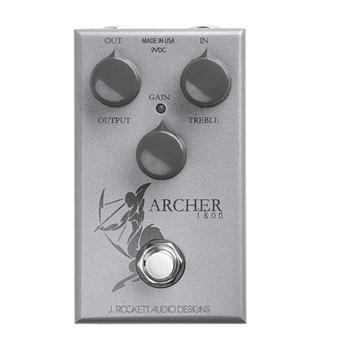
Get a Crybaby and be done with it. Don’t overthink this one…
Envelope Filter
OK, trust us. You might not think this is an essential pedal, but you may just fall in love with the idea of the envelope filter if you drop a few bucks on a used DOD 440 re-issue. If wah is kinda your thing, but you’re not the footmaster that, say Slash or Kirk Hammett is, then let the pedal do all the work. It’s not really an auto-wah in the


with buttery goodness. It’s our favorite drive ever, and you should just own one. It even gets pretty gnarly if you push the gain to the max (it also
real consideration to the op-amp reissues like the orange Billy Corgan model that came out a few years ago – they sound HUUUUGE. Don’t bother trying to restore an original unless you’re a freak like the folks at JHS (he has the box, btw). Sure, there are a lot of boutique fuzz offerings out there, and we LOVE the ones from BAE, but if you can only have one, make it count…then get the BAE anyway and lie to your accountant when they ask where all your money went. We won’t tell…
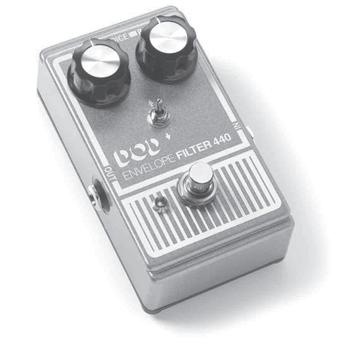
Distortion
Say it with me: RAT, RAT, RAT. Gotta have a RAT in your collection, it’s the sound of rock and roll! Every player you loved who kicks on a distortion pedal probably engaged a RAT at their feet at some point or another. There’s good reason the freaks (hey, we should probably stop calling them that because they are truly lovely people) at JHS obsesses over the RAT and its various
PERFORMER MAGAZINE DECEMBER/JANUARY 2023 33 GEAR REVIEWS
GEAR REVIEWS
incarnations and call it the best distortion ever. It is. It’s gnarly, fuzzy, aggressive and beautiful all at the same time. The new Lil’ RAT saves some space but doesn’t compromise on the circuitry inside, meaning less space taken up on your board but still an enormous RAT sound. Get one.

Phaser
Pair it with a distortion and you’ve entered full-blown EVH territory. Set it on low on your clean tone and add depth and dimension to your
back in the day. It’s lush (x2 if you engage both buttons) and dead-easy to use. Some people complained about the original version, so there’s been a revised model 2.0 that’s supposed to be better, but if you can get your hands on either one, they’re both cheap and super effective. They’ll even do stereo, which is a bonus (well, 2.0 does it correctly, apparently). And hey, gotta dig any pedal with wood paneling, right?
Tremolo
No, you don’t need one. Yes, they are super fun. No, The Smiths wouldn’t be anywhere without
a bit muddy directly in front of the amp. BONUS: it’s got a bear on it – RAWR!!
Flanger
If you’ve got a phaser in the rig, you may think a flanger is overkill. And that’s where you’d be an idiot, because more is better, haven’t we taught you anything? Now, this is gonna sound totally off-the-wall for a recommendation, but one

sound. Go full-on with the knobs and drip in watery chorus-like goodness. The Phase 90 is a classic for a reason. It’s got one knob so it’s hard to screw it up, even for folks like us. Set it, forget it, and kick it on when needed. It’s one pedal we never want to do without.
Chorus
Believe it or not, we’re not gonna recommend the obvious blue BOSS chorus. No, we really fell in love with the TC June-60 a few years back. It’s a BBD-style old school chorus that mimics the look, feel and sound of the classic built-in chorus on the Juno line of synths from Roland

one (just kidding). If you’re gonna dabble in the trem world, may as well do it right. Our favorite tremolo pedal of all time is the Kodiak from JHS. It’s got so many modes and options, and tap capabilities that it may sound overwhelming, but it’s totally whelming when you sit down to dial it in. It’s got every rhythmic variation you could want, and even with all the options, you can easily set it up in a matter of seconds and integrate it in your rig, no problem. We do recommend putting it in the fx loop, if possible, only because it can get
of our favorite flanger pedals ever is the ultracheap, plastic-enclosure ROCKTEK Flanger from the 80s. It’s ugly, purple, built cheaply and bound to fall apart, and it’s wonky as all get out when you start turning knobs, but there’s this magical sweet spot somewhere in the middle of all the knobs’ ranges that NAILS the absolute perfect flanger sound. It’s like a subtle jet engine mixed with swirly speakers floating around your head in a mad dash – and it has no right to sound this glorious for such a garbage pedal. No, there’s no rational reason to recommend a 30+ year old flanger pedal that’s no longer in production and was likely thrown away by most owners back in the day, but we never said pedal collection was a rational business, now did we?
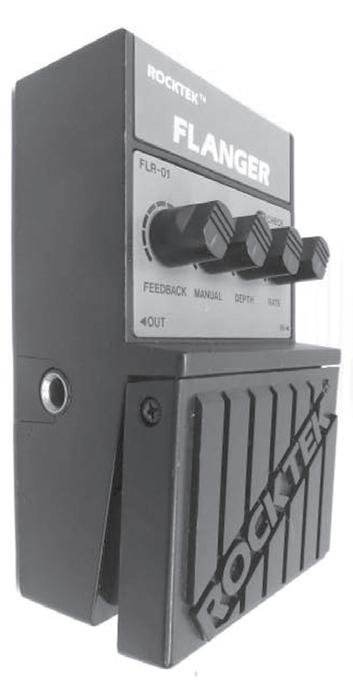
Analog Delay
CARBON COPY…COPY…COPY…COPY. The MXR greenie is the perfect analog delay pedal for under a hundo – it breaks up just like you’d want, trails off into lo-fi repeats and thankfully comes
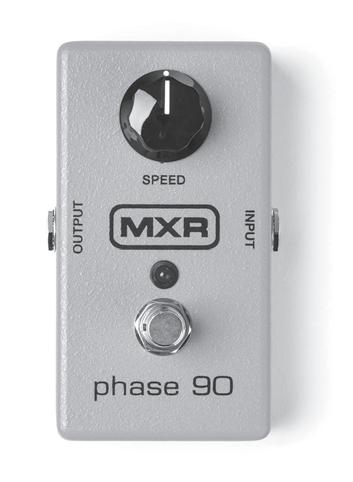
34 DECEMBER/JANUARY 2023 PERFORMER MAGAZINE
with a handy modulation button you can engage to get even more texture. This is amazing on cleans, less amazing (in our opinion) on dirty stuff, and more amazing in the fx loop.


Digital Delay
If you need something more clinical, the goto for us has been and always will be, the BOSS DD-3 Digital Delay. Get instant U2 vibes and start sounding a lot more proficient than you are by dialing in the right tempo and playing “between” the notes, just like The Edge. Trust us, once you pick up on this trick, you’re going to overuse it so much your band kicks you out, you lose your apartment, your job, your significant other and all you’ll have left in this lonely world is a small, triplet-inducing grey box fused to your cold, dead hands…Enjoy!

Reverb
Go big or go home, right? While we typically gravitate towards our amp’s built-in spring reverb, investing in a great reverb pedal does open up a whole new world of reverberation styles. You can’t do church hall openness with a spring tank, no matter how hard you try. But the real killer app on the Strymon Bluesky is the shimmering modulation you can add to your sound. It mixes in an instant ethereal quality to your arpeggios and chords and is worth the price of admission on its own. Even if you completely disregard all the ontap reverb options on the Bluesky, you’ll want to keep it just so you can listen to that shimmer for hours on end. Just be sure to place it in the fx loop of that shimmer will be shimmering mud.
So, that brings us to the end. We hope we’ve inspired you to build the biggest, most ridiculous board you can afford – just don’t blame us when the credit card bill comes at the end of the month. Happy
PERFORMER MAGAZINE DECEMBER/JANUARY 2023 35
GEAR REVIEWS
pedalin’…


36 DECEMBER/JANUARY 2023 PERFORMER MAGAZINE PEDAL FACTS What Are Each State’s Favorite Pedal Brands?
Taylor Tomita
We all have our own favorite guitar pedals.
But pedal enthusiasts in some states are searching for specific pedal brands far more than others. When looking at which pedal companies are searched the most, three main companies dominate the listElectro-Harmonix, TC Electronic, and Strymon. But the landscape becomes far more interesting when you look at what pedal companies each state is searching for at a higher-than-average rate.
So, what is each state’s uniquely most sought-out pedal company?
By analyzing Google search data, a new study from Pedal Haven was able to uncover which pedal company each state searches for the most and the most uniquely popular guitar pedal company in each state.
Find the complete study at http://www.pedalhaven.com/each-statesmost-popular-guitar-pedal-company/
Methodology
Pedal Haven set off to find each state’s most uniquely popular and most searched guitar pedal brands. To do this, they compiled an extensive list of guitar pedal manufacturers - using the top pedal companies from their “Most Popular Pedals” studies from 2021 and 2020, Reverb.com’s best-selling pedals reports, and asking friends in the industry for their recommendations of pedal companies to add to the list.
Then, they gathered search volume data for each pedal company on a state-by-state level using KeywordTool.io.
To find the most-uniquely popular pedal company in each state, they crunched the numbers to compare each pedal company’s share of the total national search volume against the same pedal company’s share of the search volume in a specific state. The companies that were searched, on average, most in a certain state when compared to the U.S. as a whole were deemed the “most uniquely popular” in that state.

For example, people in Florida search for ZVEX Effects’ pedal at a higher-than-average rate when compared to the U.S. as a whole - thus ZVEX is Florida’s most uniquely popular pedal company.
To find the most searched for pedal companies in each state, Pedal Haven simply found which company had the highest search volume in each state. This list was dominated by three companiesElectro Harmonix, TC Electronic, and Strymon.
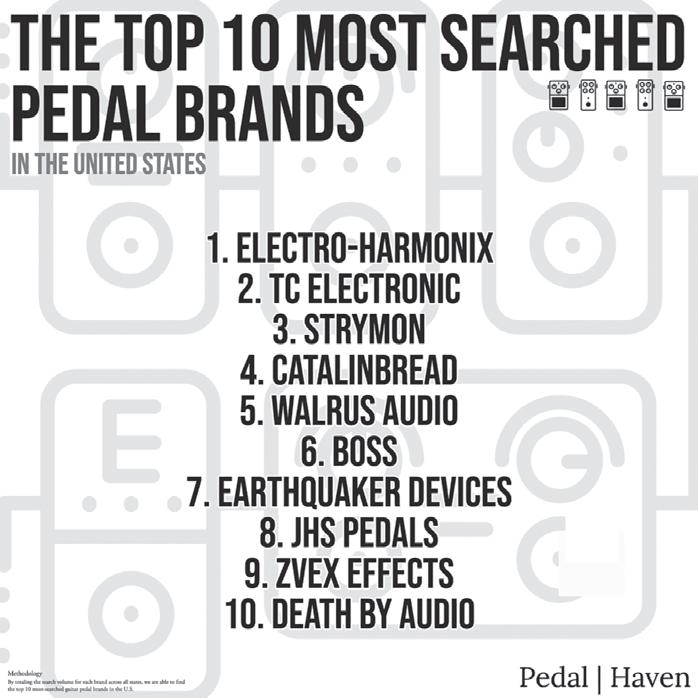
About Pedal Haven
Pedal Haven is a website dedicated to all-thingsguitar-pedals. Their website exists to provide guitar pedals news, DIY pedal building information, shopping guides, pedal reviews, demos, and more. Learn more at http://www.pedalhaven.com and follow on Instagram at @PedalHaven
PERFORMER MAGAZINE DECEMBER/JANUARY 2023 37 PEDAL FACTS
How to Take Your Pedalboard WIRELESS
with Ryan Krysiak of First to Eleven
We recently hooked up the band First to Eleven with a bunch of new Xvive Wireless gear as part of a video project we produced for YouTube, showing bands just how easy and affordable it can be to get set up to go wireless on stage: including mics, guitars, in-ears and more.
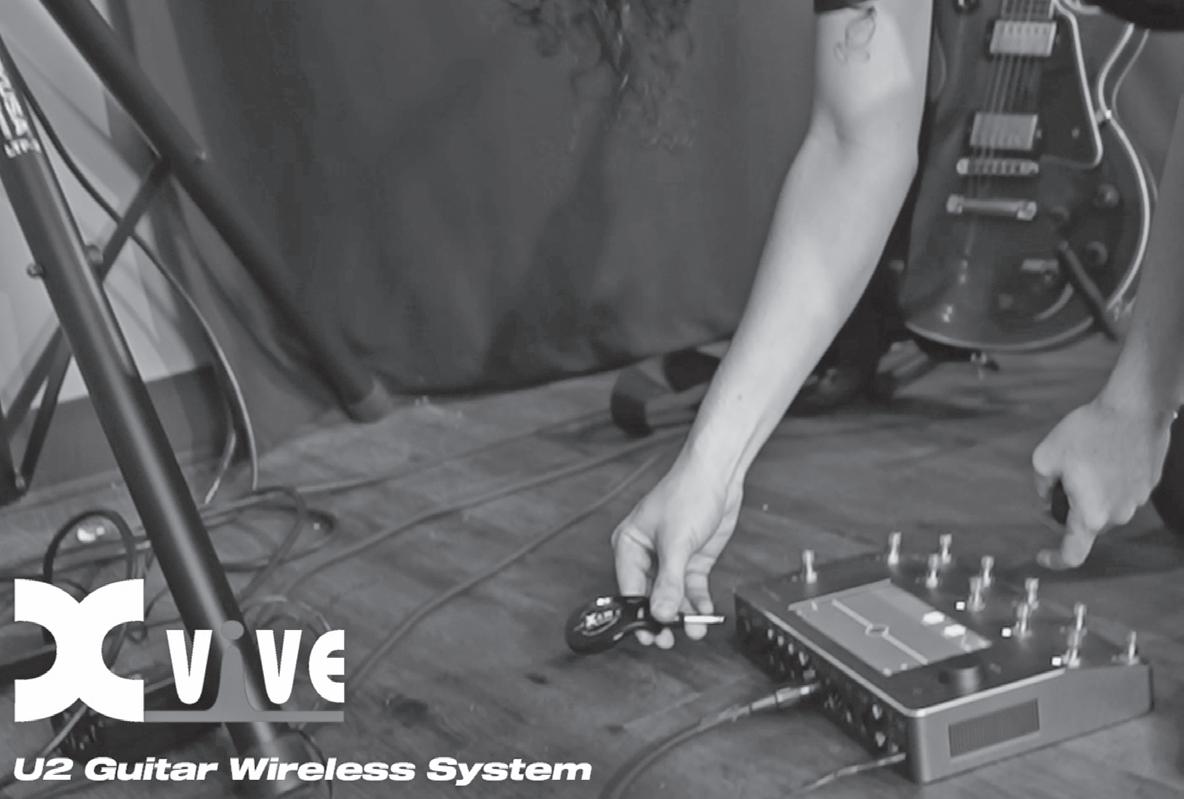
After the shoot, we sat down with bandmember Ryan Krysiak to talk more specifically on the guitar side of things – if you’ve never considered going wireless before, or taking your pedalboard wireless, keep reading to hear his thoughts and tips for fellow musicians. We featured the Xvive U2 Wireless Guitar system in the video series (watch them on our YouTube channel for a complete setup guide) and you’d be amazed just how simple it can be to go wirelessly from your guitar’s output jack directly to the input on your pedalboard or straight into the amp.
For more, follow the band on Instagram at @firsttoeleven. And check out the entire range of Xvive gear at https://xvive.com.
Wireless was a really dirty word for bands when I was coming up because it meant expensive. It meant big bulky rack units, and it meant the units that you bought sometimes weren’t the greatest and often had a lot of interference. Having used wireless yourself with the band, what’s your experience been like? What do you see wireless being like for bands today? Is it easy? Is it affordable? Is it simple to use and get into?
Yeah, I think it’s literally all of those things. It is easy. It is affordable. The ease of use has changed a lot even since I’ve been playing music, over the past 20 years. I started out with a half

stack and then I would be like, ‘alright, that’s getting annoying, so let’s go down to a combo amp’ and it was like ‘wow, these combo amps are great, I can pick it up with one hand and I don’t need two people to move it,’ and then you kind of evolve even further. You’re like, ‘alright, let’s get into the digital modeling stuff’ -- so now we’ve got this box and there’s no speaker cabinets and we’re just getting more and more efficient with how we play music.
What we do is primarily make music videos. We perform live, but we make content for YouTube so we [are always] trying to make our setup and our playback for our YouTube videos, and that’s where the Xvive stuff has been so helpful because we used to bring studio monitors that we would plug in for playback and we would have to crank it because we needed to hear it over the drums.
GEAR REVIEWS 38 DECEMBER/JANUARY 2023 PERFORMER MAGAZINE
We’re [always] trying to play along with these songs and stay in time so that we can sync the audio and the video later.
Eventually, we were like, ‘What if we just get rid of these monitors entirely? And what if we just use [wireless] in-ears during the video so [drummer] Sam stays in time?’ I can hear the kick drum, so I’m playing along, you know, in perfect time with the drums and we’re alright. Well now… we don’t need all of our other stuff. We don’t need our full PA system. We don’t need our amps and stuff like that. We got Xvive [wireless] for playback and we literally just have a cable going from our phone into the transmitter that sends to the receivers and we all have our receivers in this little purse-sized thing -- and that’s how we handle playback [now].
Everything is wireless. No external power;
everything is self-contained. It’s all in this little carrying case. All our in-ears are in there and we just show up. We pull out our receivers. We plug in our in-ears and we’re ready to shoot and everything is in perfect sync and it’s just it’s as easy as…I can’t imagine it getting any easier than it currently is.
What I’ve heard from a lot of groups, is that transmission quality issues and the dropouts are kind of a thing of the past. That was the bane of my existence 20/25 years ago with wireless units, there’d always be interference. There’d always be dropouts and lags, and it seems like for the most part most of the gear that you can get wirelessly these days eliminates the majority of those issues. Is that right?
Yeah, the Xvive stuff…it’s just ‘[press] Channel 1, Channel 2, Channel 3, Channel 4’ and it makes it so much easier because I remember previously, we would have these wireless units that you had to basically break out the owners manual to sync the transmitter and the receiver with each other.
[Now] you just make sure they’re on the same channel and you are instantly in it. [Previously] every unit was different whether it was from one brand or another. It was like, ‘I forget how to use these ones versus these other ones.’
And you know, it’s always the worst time possible, like two minutes before you’re supposed to start playing that you have that issue. And now, you know, if there is any interference at all [during set up], which usually there isn’t, it’s alright. We’ll just try the next channel and then boom, it’s gone.
With guitar units, it used to be all huge rackmount stuff, so you’d have a big wheelie case that would weigh 1000 pounds. And the guitar stuff that I saw in the videos that you guys made for Xvive, it’s one transmitter unit that’s maybe the size of a credit card that plugs into the guitar and the receiver can just go right into your pedal board. It looks that simple.
Oh yeah, I mean that comes in handy. We do a lot of stuff that is fly dates. You know what I mean? Someone will be like, ‘hey fly down to Florida, come and play this event’ or you know, ‘fly to Tennessee and play this event’ and we started out with big rack cases and we would check them [on the plane] and they would be overweight…but that’s how we used to do it. And now almost everything that I play with personally on-stage fits in my guitar case.
That’s awesome.
So, I have one of those double guitar cases. I
have my main and my back up and then I’ve got my wireless [units], my tuner, and everything is all contained in that one case.
Yeah, I got to imagine for bands who are playing live and like you said, doing fly dates or even just going out on tour -- you don’t want to pack all that stuff into a van or a bus. And schlep it out to every gig and load it in, load it out night after night. I mean, you’ve got everything in your guitar case, that’s amazing.
Yeah, and you can never go backwards. You know what I mean? You kind of laugh at the stuff that you used to do, because it’s comparatively so much more work. But I mean the point that we’re at right now, you have to hustle a lot as a musician to be able to pay the bills and stay above water. And you know just to be able to go and shoot a music video and have it not take all day from carrying equipment in and out or worrying about like what you said with signal dropouts and changing frequencies and stuff like that -- to be able to just show up.

Time is money, right?
Yeah, three or four takes [of a music video] and then we pack up our stuff, which again is super easy. Back to the studio and we can start working on some other projects. We can start recording …instead of packing up for a show and having it take two hours. [Now], you can pack up for a show in 30 minutes, right? We’re just trying to find the easiest, simplest, most efficient way to do everything.
And lastly, of course, from a practical standpoint, I’ve got to imagine if there’s four or five of you on stage, and you’re moving around, not having all those wires on the floor tangled up, tripping over them. I mean, it’s got to be just a little bit cleaner and easier to move around and perform, right?
Oh yeah, for sure. I’ve used wireless units for a really long time, even at practice. You know when you would traditionally just pull out a cable because it’s just practice? But now these units are so affordable, and the batteries charge so quickly and they last for so long. It’s like, why not be wireless? Even at practice? You know what I mean? You can just have this thing readily available. And boom, it’s on, it’s plugged in. You don’t have to wrap the cable at the end. One of my personal pet peeves is how dirty your hands get as you’re wrapping the cables…it feels weird when you do go back to using a [cable] -- it feels like you’re wearing like a turtleneck. You’re aware that it’s there. That cable being under your foot or brushing up against your leg…once you get away from it, you’re like, ‘oh, this is so nice.’ And then you can’t go back. You can never go back…

PERFORMER MAGAZINE DECEMBER/JANUARY 2023 39 GEAR REVIEWS
Benjamin Ricci
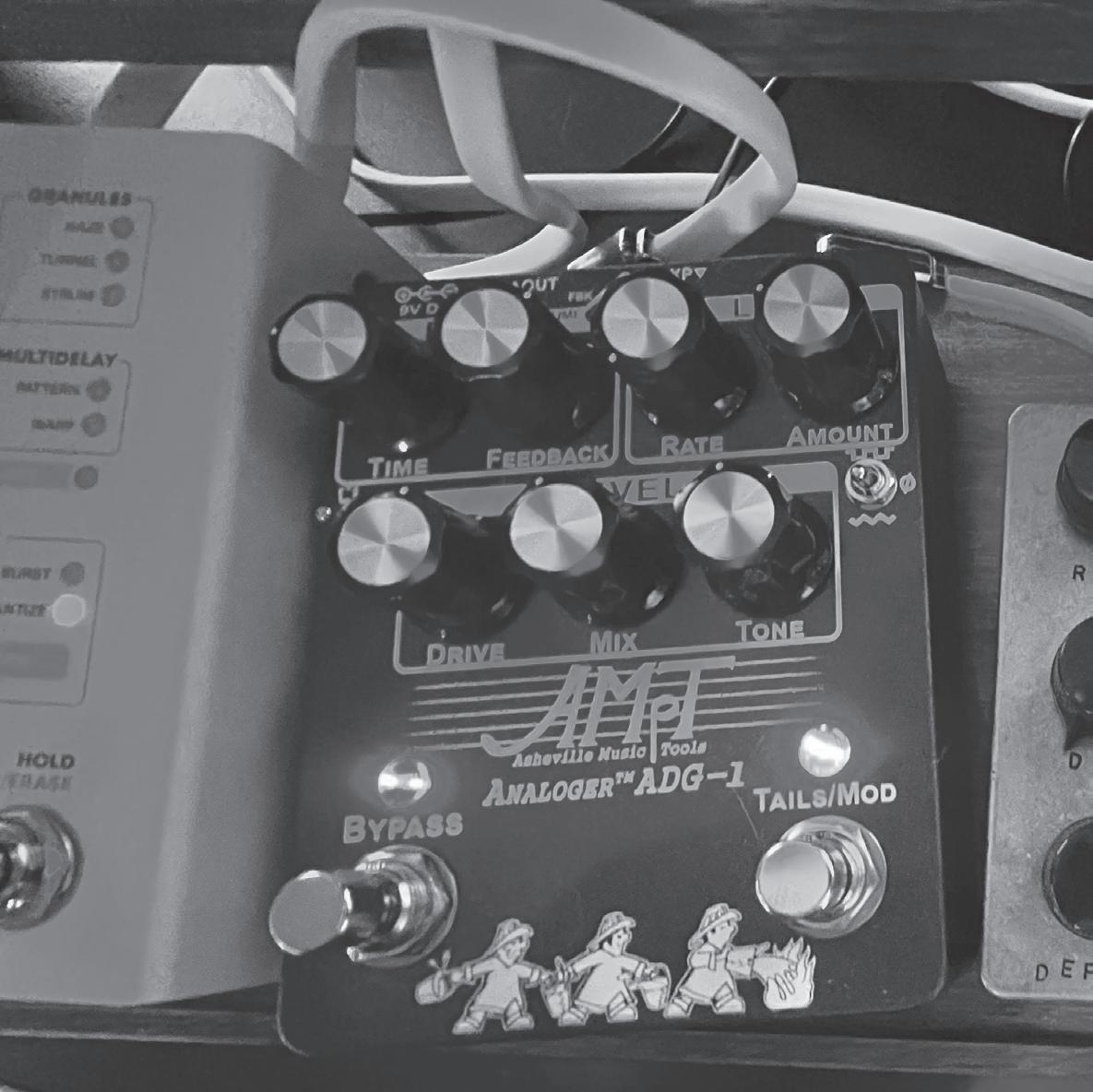
40 DECEMBER/JANUARY 2023 PERFORMER MAGAZINE GEAR REVIEWS My Favorite Pedal(s) with Kyle Andrews
One of my absolute favorite pedals is the Analoger ADG-1 bucket brigade delay (BBD). The drive provides a really nice distortion, and the modulation can be subtle or totally wild. You can check out more about this pedal and the entire Asheville Music Tools lineup at https://www. ashevillemusictools.com
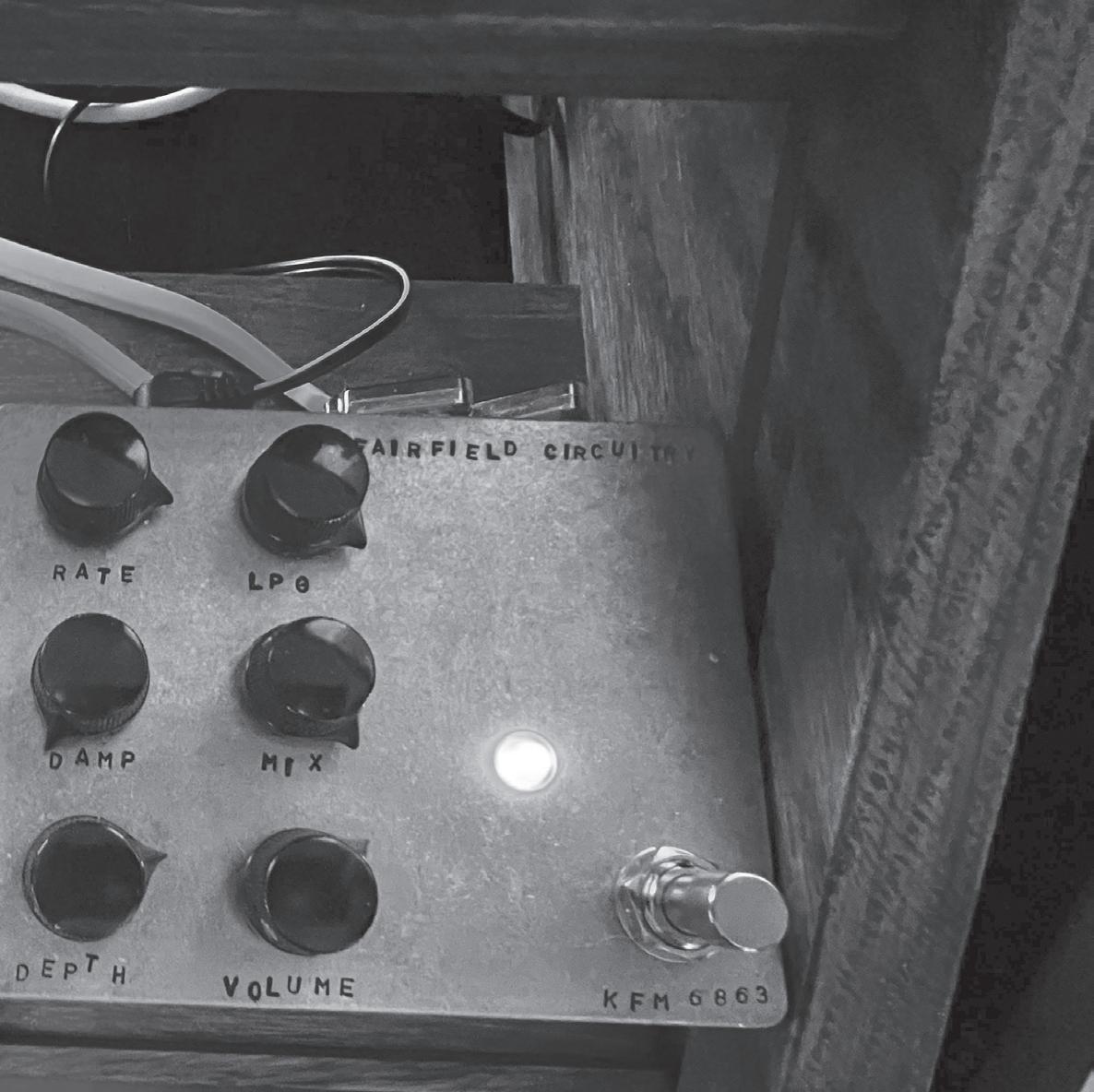
I heard about the Analoger ADG-1 from Emily the Harpist. Generally, I keep the delay set to a shorter slapback. If I want to get freaky, I’ll turn the feedback way up on a shorter time
setting. Hit the tail mod button, and it takes on tons of personality. Dirty and fun.
My other fave is the Fairfield Circuitry Shallow Water, which does the whole woozy tape warp sound perfectly. It’s first in my chain, and I keep it on most of the time. I used this effect heavily on the Mal Blum EP I produced this year. On “Stockpiled Guns & TV Dinners” you can hear it warping the guitars.
Check it out and more at https:// fairfieldcircuitry.com
I often combine these two when I want to really mess things up!
Both of these are my go-to pedals when things are sounding too “normal.” Drum machines, bass, guitars, keyboards, strings, vocals have all run through these two at some point.
Check out more of my music to hear these pedals in action at http://www.kyleandrews. com

PERFORMER MAGAZINE DECEMBER/JANUARY 2023 41 GEAR
REVIEWS
GEAR REVIEWS

My Favorite Pedal with Martin Newman
ABOUT THE ARTIST
I started playing metal in Germany then moved to the States and began playing ethereal/ shoegaze. Currently, I reside in NY and am playing guitar in Iceblynk and with shoegaze legends the Veldt.

MAKE AND MODEL
2019 Mastro Valvola - Lysergic Emotions Module (aka LEM). Learn more at https://www. mastrovalvola.it
WHAT IT MEANS TO YOU
This pedal has revolutionized my playing. Bringing the ambient and textures you’d expect from a synth and letting you accent or overwhelm any guitar part, depending on how deep you want to go. It sounds like dreams, very hypnotic. Variables from shimmer to steps and dual head and reverse delay. I haven’t even uncovered all its capabilities yet.
SPECIAL FEATURE
Timed bypass to control the trails.
CAN BE HEARD ON
I used this all over the latest Iceblynk EP. Almost anytime you think you’re hearing a synth its most likely the LEM, most prominently on “Imagined Life.” Also used on Plumerai’s “Like Water.”
LISTEN NOW http://iceblynk.bandcamp.com
42 DECEMBER/JANUARY 2023 PERFORMER MAGAZINE
James Newman
Pedalbay 40 and 60
The slat wall pedalboard design has offered up a platform for guitarists that is flexible, but always needed add-ons such as power supplies and mounting brackets. Palmer’s Pedalbay system is an all-in-one package that can support and power pedals with ease.

The sizes are reasonable, with the 40PB at 17.75” wide and the 60PB is 23.75’’ wide and both have a 12” depth. The slat design allows for audio and power cables to snake under the boards. Each board is constructed of black coated aluminum and is done with a bolt-together design for the cross members. Palmer has thought ahead on the design with the ability to move the center slats via hex bolts. Ever try to put a pedal at the bottom edge of a slat pedalboard, the top half just hangs off the edge, meaning it has to be placed to catch two slats, and eats up precious space? The adjustability tailors the spacing to the pedals. Thankfully each comes full assembled, and the main platforms have the soft side of Velcro already installed. Threaded rubber feet fitted with ball joints provide a decent angle that’s common on pedalboards these days. The overall construction feels durable and robust as well.
For an all-in-one design Palmer has designed a power bar system; simply unbolt one of the cross members and replace it with the power bar which is designed to work with the existing hardware with no issues, and includes an extra package of nuts for mounting it in place of the back cross member. Palmer has also included a stretch of extra Velcro to apply on top of the power bar
as needed. With the standard center negative pin connections, the power bar has selectable outputs for 9V, 12V or 18V. Six 9V at 300Milliamp connections also are available, along with the ability to run a 12V 2amp output to an additional power supply. LED indicator lights are also there for status. For optimum power cable routing, a cable management tray is also included for when using the power bar as the rear crossmember. The 9v power supply and cables for powering pedals are included, as well as a sturdy nylon carry bag with heavy duty zippers, shoulder strap, and storage pouch.
Loading these up with pedals big and small was no issue across the board (pun intended). Being able to make a nice tight and simple rig on the 40 with a Revv Tilt, Earthquaker Wildwood, Vintage Boss CE1, Earthquaker Astral Destiny, EHX Synth 9 and TC tuner. Placement wasn’t an issue, but it was a tight board that offered up plenty of options. The 60 is quite a bit wider, and larger pedals like Death by Audio’s Fuzz War, Amplitube’s X-space Reverb and Coppersound’s TripleGraph still gave us a lot more space to work with, and less chance of hitting a footswitch by accident. Both the 40PB & 60PB have the same power configurations and with that extra width it would have been nice to be able to power at least two extra pedals.
Overall, the modular design makes it very adaptable, and the included power supply makes this an all-in-one configuration that’s very player friendly.
Chris Devine
PERFORMER MAGAZINE DECEMBER/JANUARY 2023 43 GEAR REVIEWS
CONS
@ $269 Pedalbay60 @ $299 STREET PRICE
PROS PALMER
The power bar on the larger 60PB could use an extra output or two.
Pedalbay40
modular design, all in one package, excellent power options
Pedalboards
Pedalboard power supplies are often overlooked, but it’s an area that can not only mess with your pedalboard, but with your pedals themselves. Palmer’s PWT08 has plenty of clean and safe power on tap, so consider adding one to power your board today.
There are eight 2.1mm negative center pin connections that should work with most pedal types. However, as there are those unique pedals that might need different voltages, two of the connections have selectable outputs of 9, 12, and 18 volts at 150 Milliamps. Some drive and preamp pedals can easily handle the 18V, so having this option is great for those needs.
The remainder of the outputs are rated at 500 Milliamps, and should be able to handle large format pedal power requirements with ease (think Strymon, etc). For even more power,

a Y-cable is included to bridge two of the outputs for additional voltage up to 36V. Each output connection is isolated and protected against overloads and has a LED status indicator. With the selection of pedals we used, there were no roadblocks on getting power to strange and unique pedals like Coppersound’s TripleGraph or the IK Amplitube X-Space, along with traditional Boss and MXR style units. As always, double check what your pedals require BEFORE plugging anything in.
It’s a nice and simple power supply for any pedalboard that won’t break the bank, or your precious effects pedals. If you’ve been batterypowered for years, consider making the upgrade to avoid dead pedals at the worst possible moment. Trust us, you and your audience will be glad you did.
Devine
44 DECEMBER/JANUARY 2023 PERFORMER MAGAZINE GEAR REVIEWS
None CONS $140 STREET PRICE Plenty of output options, small and compact PROS
Chris
PALMER PWT08 Powerbar
COPPERSOUND
Strategy Two Channel Preamp and Overdrive V2
Back in March of 2021 we reviewed Coppersound’s Strategy pedal. The cool Strat-inspired design is as unique as the sound, and now Coppersound has updated it with an additional overdrive mode.
PROS
Preamp mode is articulate and very adjustable, overdrive is very natural, perfect pairing of preamp and drive
Again, the blend of Stratocaster and stompbox design is still there, and for players wanting to take that to a new level, ordering a custom version (even relic’d) to match your guitars is still available. Inside the electronics are based around audio grade Burr Brown Op Amp, along with some unique switching options. We received the Ice Blue metallic, with chrome hardware, a tortoise shell guard, and white knobs.
The traditional Preamp mode is still here, with the volume covering the overall output, and the tone control is a high/low pass filter, the mid point is at about 5 -- below that and it starts enhancing the lows, while rolling off high end. Going up from 5, the high frequencies are enhanced, while rolling off low end.
On its own it’s a good way to get “more,” -not to repeat our previous review, but plugging it into a variety of amps as well as a couple of IR loaders and amp sims, it really allows for some serious tonal enhancement. With the volume lower, boosting the highs slightly added a nice glassiness. For players who might have a darker amp, this is a great tool to add in more highs that are practical for guitar. It also pairs nicely with other pedals for gain stacking and works well with other drive pedals.
The update however is an added Overdrive mode, engaged by the mini toggle on the back of the pedal. The ultra-bright LED is blue in the traditional preamp mode, and switches to yellow in overdrive mode. It’s a low- to midgain drive, think of it as a “second stage” to the preamp mode. It’s certainly sweeter and grittier. Need that lil tube combo to jump a bit more? This will do the trick. The drive feels like it’s part of the amp itself and when it’s maxed out it’s glorious, rich, full and thick. Picking and volume attack changes make it very reactive to a player and their guitar. There is an additional Internal Gain pot that allows the player to dial in more or less saturation (it comes from the factory set to 50%), which had a nice semi-open response; in high gain settings the saturation smoothed things out just enough to change the character to a tighter and thicker feel.
A smart bypass mode offers some unique options; holding the switch down engages a momentary mode, perfect for making a quick lick or lead jump out of the mix. This is great in both the preamp and overdrive modes, and it can be shut off via an internal dip switch to prevent any user errors or accidents.

A great application for this is on a fly rig where you never know what you’re going to get for a backline amp. Like its predecessor, the aesthetic makes it stand out visually but the sound makes it stand out to everyone who can’t see your pedalboard.
Chris Devine
PERFORMER MAGAZINE DECEMBER/JANUARY 2023 45 GEAR REVIEWS
None CONS $279 STREET PRICE
PIGTRONIX
Star Eater Analog Fuzz Pedal

Not all fuzzes are created equal; the various vintages and versions, the tweaks, the re-issues, the everythingin-one model configurations. It’s overwhelming to sort through. Pigtronix has unleashed their new Star Eater, and its options are practical for what a fuzz is, without confusion.
The Captain Picard-approved “engage” switch starts things off, with a volume controlling the output level, and the hunger control covering the level of the fuzz. The tweaking starts here, with the voicing switch allowing the user to choose between silicon or germanium diodes doing the work of clipping the signal for the fuzz’s character. Pigtronix states that the transistors are matched for the optimum sweet spot of fuzz. We can’t argue with that.
For additional tonal sculpting the contour side offers up either a mid-range bump or scoop with its rocker switch, and further adjustability of that choice via the sweep control. Fuzzes also behave strangely with various batteries, and to keep things consistent on the power end of things, it needs to be powered by a 9v power supply.
For the record, germanium fuzzes are usually very smooth, while the silicon versions are a bit
more in-your-face and punchy. Starting off with the germanium side, that smoothness is certainly present, and very interactive with the hunger control. When switching to the silicon diodes, the fuzz level can be a bit harsh, and depending on the tone desired, rolling it back opens up the sound a bit more. One isn’t better than the other, it’s a taste and feel situation. On a Strat with the neck pickup, re-live classic rock with gobs of sustain and voodoo, and with a humbucker and a hardtail, those low end power chords scream desert rock sludgyness.
The contour option helps minimize a trait that fuzzes have, which is getting so fuzzy and saturated, that the effect can get lost in the mix, especially live. The scoop mode was VERY VERY scooped. In the germanium mode this was so smooth and compressed it was amazingly saturated in leads, and the chords were like a down pillow. Going to the mid bump was the opposite end of the spectrum, with enough jump to the signal to get a bit more cut and presence to be felt.
Size wise it’s also quite small for a fuzz, with “vintage spec” versions of certain fuzz models being quite large, the size is perfect for pedalboards where space is at a premium.
Considering the market is flooded with fuzzes of all types and price points, this is a perfect choice for the player who wants a fuzz, but might be on the fence because of all the variants; this isn’t a compromise on any particular version(s), it simply offers up the practical options that a player would want, and not catering to what a forum or Facebook group would dictate is the “best” kind of fuzz.
Chris Devine
46 DECEMBER/JANUARY 2023 PERFORMER MAGAZINE
CONS
STREET PRICE $179
None.
Excellent
fuzz tones, plenty of tweakability and options
PROS
GEAR REVIEWS
Shawn Tubbs Tilt Overdrive Pedal

In case you didn’t know, Shawn Tubbs is a highly regarded session player, and one thing session folks know is tone. The Tilt Overdrive is a collaboration with Shawn and Revv, and has a few tricks up its sleeve.
It’s a medium gain drive pedal with a boost; the drive side is voiced like a tube amp when engaged, and certainly has a clear vintage slant to things, however it’s not an “amp in the box” design. Lower gain settings certainly have Fullerton type of dynamics that interact with pick attack and cranking things up adds in a sharper and more focused response. Maxing out the gain brings the sound into classic the “Union Jack” zone, while still responding to the player’s attack, like a vintage amp should.
EQ wise the treble control has a huge range -- at lower settings it’s not really there, but after 12 o’clock, it starts to brighten up a lot more. The bass knob is kind of a mislead, the EQ voicing covers most of the low mids, and responds like it was spec’d out by ears and not component values. At zero, it feels neutral, and as it’s increased the bottom end comes in, but stays in the guitar’s optimum range, and doesn’t get woofy or muffled.
The boost side gets interesting with 12Db of “more” on tap, with its own independent level and the “TILTEQ” doing the tonal shaping. Set all the way to the left, and it’s quite bright, and as
it’s turned clockwise, lows are added in while the high end gets cut.
One thing to note: if a player has it in their head where the knobs “should” be on a similar pedal, throw that thinking out the window. The uniqueness of this pedal is that the tonal adjustments are meant to be in the optimum guitar ranges for mid gain playing -- find the tone, and let the knobs fall where they sound best.
Footswitch wise it has some extra options; holding down the drive footswitch for 1.5 seconds will turn off both the boost and drive functions at the same time. Hate having to turn pedals on (or off) when starting up your rig? Well, hold down the footswitch while powering up the pedal, and it can toggle between being “on” when your rig gets turned on, and it works for both boost and drive sides.
While the Tilt may have been the brainchild of a studio cat, in the wild of a live setting having the tweakability can be useful and makes fine-tuning your tone for the room very easy. This isn’t a blunt force approach; the Tilt is more of a tonal scalpel. With the very interactive EQ on both sides, it’s approaching the drive tones as a producer would, looking for results in small enough increments that make a difference in the overall mix of music, and not the guitar slinger’s mind.
Chris Devine
Clear, refined, articulate, reactive to playing, great drive tones, plenty of tweakability
PERFORMER MAGAZINE DECEMBER/JANUARY 2023 47 GEAR REVIEWS
STREET PRICE $269
CONS None.
REVV
PROS
DONNER
Arena 2000 Multi-Effect Processor
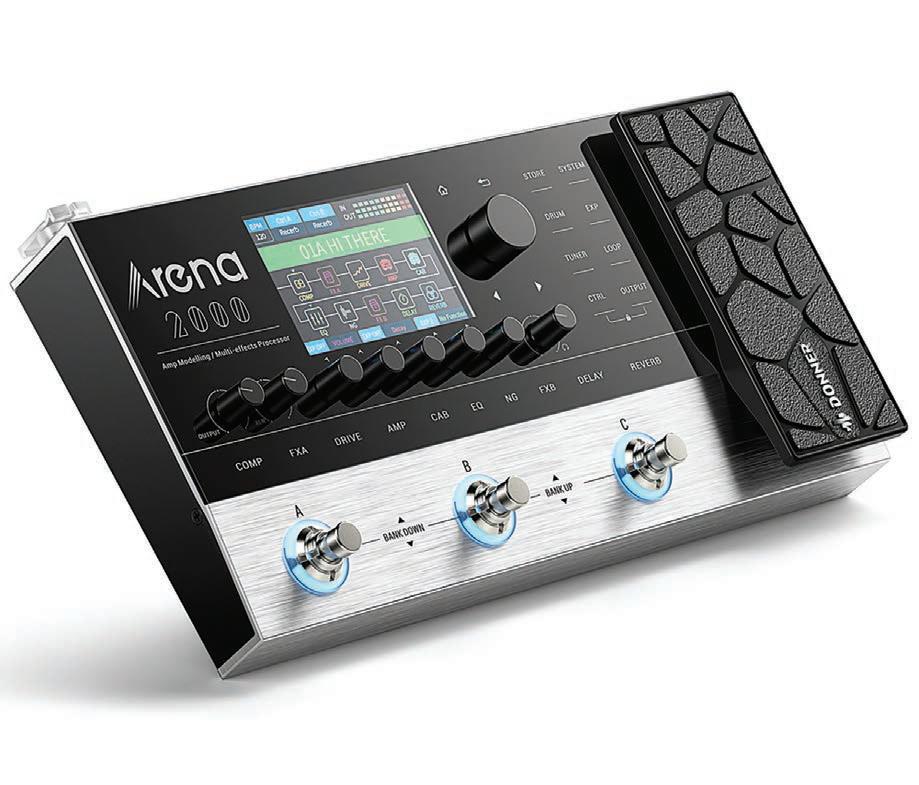
Donner’s Arena 2000 is re-setting the bar in terms of price per performance in multi-fx units.

The controls are a combination of touch screen and parameter controls. Strangely the display screen isn’t a touch control surface, but just a display. The effects selections and system editing are touch activated, however, with a master scroll wheel to navigate. The three footswitches are backlit and multi-functional. These can be set to go through the 50 banks, each with three presets. When engaging a specific preset, the footswitches can then be engaged to turn off specific chosen effects or a engage secondary function like a tuner as desired. On the right side there is an expression pedal that can also be set specifically for an effect’s particular parameter, or as a simple volume pedal.
Connectivity is pretty simple, with MIDI in, 1/4” input, stereo 1/4” and balanced XLR outputs. USB-C allows the unit to be connected to a computer for additional editing from Donner’s software, or for use as a DAW interface. For personal practice, a headphone jack is available, and for extra expandability, there’s a connection for an additional expression pedal or footswitches. The Arena is also Bluetooth compatible, with an app editing software making
it easy to make deep changes on the fly. The Bluetooth editing functionality is really nice, with a larger screen on an iPhone or iPad, but the computer app allows for loading of your own impulse responses.
The sounds are quite amazing, with a deep selection of amps and cabs, going far beyond the typical Fender/Marshall/Vox stuff, how about a PRS Archon or Matchless? Still too common for you? Well, there are 80 amps in total, and it gets into the weeds with Suhr and Divided by 13 models, as well. There are also microphone options and effects. Drive pedals options are quite extensive as well, with variants of TS units to Klons being emulated. The time-based effects are pretty standard though; one omission that’s kind of surprising is the shimmer reverb/delay effect, but the modulations, delays and reverbs certainly aren’t lacking otherwise.
Acoustic players, there are even acoustic amps emulated, so singer/songwriters looking for a good selection of effects and such can easily be satisfied. A drum machine with 40 patterns as well as a looping function is also available, and makes this a band in a box unit for players who are familiar with loopers. The ability to add additional footswitches here is very much
appreciated for the looping and drum machine features.
Soundwise it really kicks butt; presets certainly favor more hard rock and metal tastes, but with a bit of editing it’s easy to generate sounds for pretty much any musical style. With the app and software, the signal chain can be easily altered, however on the unit itself, not so much. The overall sounds certainly delivers a high-quality experience, and it’s quite shocking given the unit’s price point.
What’s the best way to use this? Well, in front of an amp (ideally two amps, it’s stereo) the 1/4” outputs can be set to not use the cab simulations, while the XLRs could run the cab sims to the PA system, so it’s flexible for live use with or without a traditional amp. The USB out can be set for a dry or effected signal, too.
Considering the size, functionality and overall sounds, it’s quite impressive. Bedroom and basement players have the same options and sound quality as higher priced units, while weekend warriors have a rig that can fit into a backpack. For pro level players doing fly dates, this can make for an inexpensive option or even as a backup.
Chris Devine
48 DECEMBER/JANUARY 2023 PERFORMER MAGAZINE
GEAR REVIEWS
STREET
$269
PROS
CONS Presets favor harder styles. On-board editing lacks features available on app and computer
PRICE
Great selection of amps and effects, easy to edit, small size, great price
The latest addition to the iconic 20 Series – the microphone line that made professional audio accessible to all – the AT2020USB-X combines the studio-quality articulation and intelligibility of it's predecessor, the AT2020USB+. Featuring USB-C output, silent mute switch, rugged desk stand, and hi-res operation (up to 24-bit/96 kHz) the versatile AT2020USB-X is ideal for musicians, streamers, podcasters, and other content creators. Your personal studio is here.





















/ AT2020USB-X Cardioid Condenser USB Microphone Advanced Performance for All Creators audio-technica.com
A passion for playing means that inspiration can strike anytime, anywhere. With Elixir® Strings you know that when you pick up your guitar it’s going to sound great—time and time again. That’s because our featherweight coating protects your strings from the elements, keeping corrosion away and allowing your tone to sound great for longer, in any environment.

Elixir Strings. Performance-ready with long-lasting tone.















































•
GOOD TO GO WHENWHERE
EVER VER
GORE, Together, improving life, ELIXIR, NANOWEB, POLYWEB, OPTIWEB, GREAT TONE • LONG LIFE, “e” icon, and designs are trademarks of W. L. Gore & Associates. ©2009-2022
W. L. Gore & Associates, Inc.



































 by Kim Bjorn and Scott Harper
by Kim Bjorn and Scott Harper


























































 Benjamin Ricci
Benjamin Ricci






























































